There’s also a fully searchable index covering the complete thin section set, listing for each sample its locality, the anticipated major minerals, a brief generalized geologic environment description, and where appropriate, the nature of any unusual element enrichments.
Note: Depending on the speed of your internet connection, it could take a minute or two for the images to load. If after the page looks like it’s finished loading but some of the thin section images appear to be missing, reloading the page will typically fix the problem.

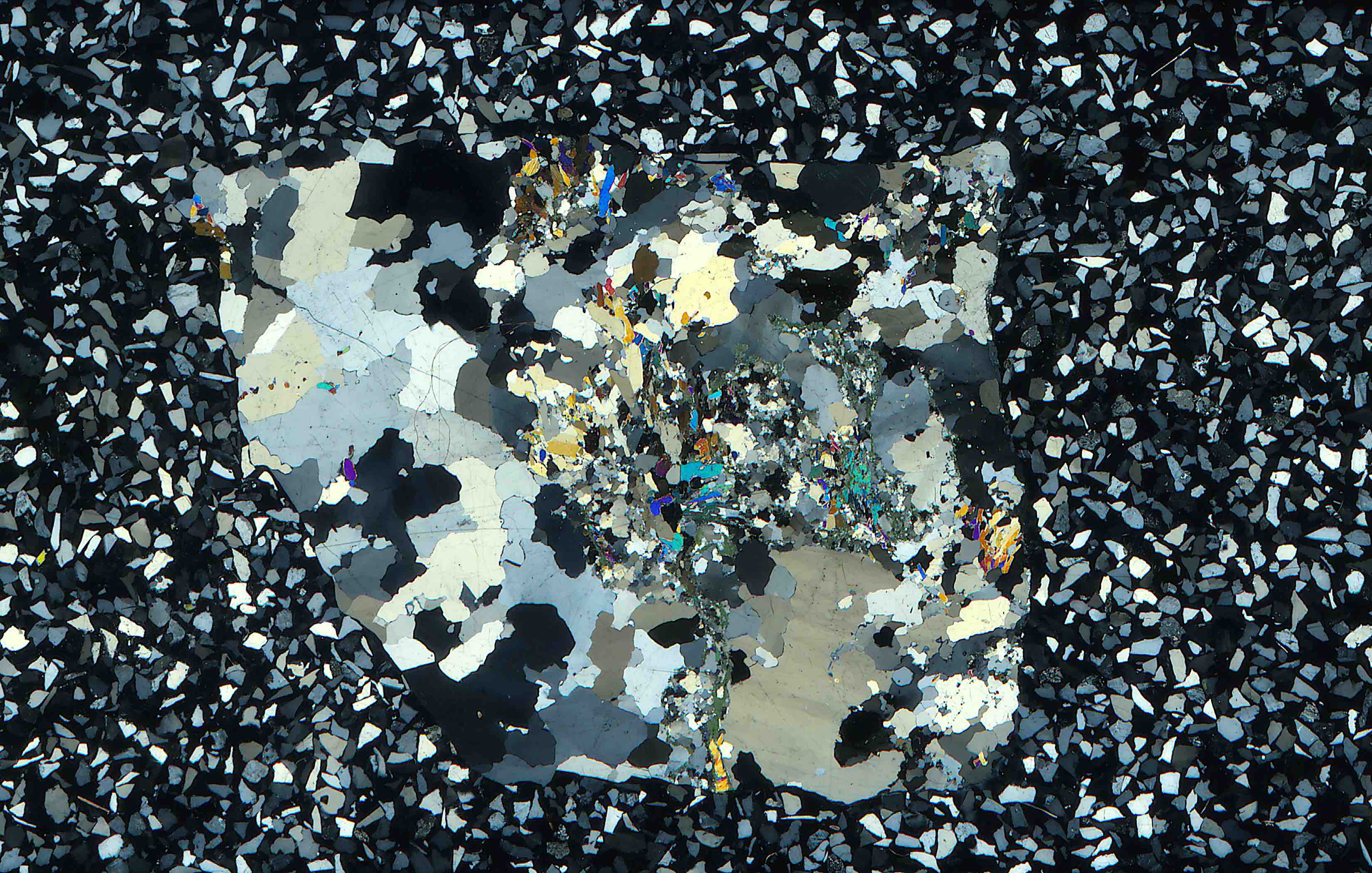
left image: unpolarized light; right image: under crossed polarizers; use slider in center to view more of either image
sample: FKM-276
locality: American #1 talc mine, Balmat, St. Lawrence Co., NY, USA.
rock type: tourmaline-tremolite-quartz calc-silicate. Amphibolite to granulite facies calcareous meta-evaporite, with superimposed metasomatism.
major mineralogy: The specimen was acquired for a chromium-rich tourmaline identified on the dealer label as chromium-dravite. The tourmaline occurs as clumps of tiny crystals in thin stringers in a Cr-bearing tremolite+quartz-dominant rock. Minor fluorapatite and sparse zircon are also present. Although originally identified as chromium-dravite (and later thought to perhaps really be chromo-alumino-povondraite, due to that species’ known occurrence at Balmat), subsequent microprobe analysis of the tourmaline indicated it is actually weakly-zoned oxy-chromium-dravite. According to the characterization of compositionally-similar chromo-alumino-povondraite by Reznitskii et al., 2014, along the Cr-Al join, the Y+Z occupancy of oxy-chromium-dravite ranges from the ideal all-Cr end-member YCr3Z(Cr4Mg2) down to a mixed Cr-Al composition of YCr3Z(Cr2Al2Mg2). These compositional limits correspond to a range of (Y+Z)[Cr/(Cr+Al)] from 1.00 down to 0.71, respectively; both the measured core and rim analyses fall within this range (see table), although the rim analysis in particular closely approaches the boundary with chromo-alumino-povondraite (the field of which spans a range of (Y+Z)[Cr/(Cr+Al)] from the aforementioned Cr-dominant value of 0.71 down to the Al-dominant value of 0.21 [i.e. this latter value corresponding to a site occupancy of Y(Cr1.5Al1.5)Z(Al4Mg2)]). Note that the specific cation distributions of Cr and Mg listed in the composition table for the Y and Z sites have not been experimentally verified, but simply represent plausible cation distributions.
| mineral | representative mineral compositions in FKM-276 |
|---|---|
| fluorapatite | (Ca4.96Sr0.02Mn2+0.01)[P0.993Si0.003S0.003O4]3(F0.80[OH]0.18Cl0.02) |
| zircon | not analyzed |
| oxy-chromium-dravite (core; most Cr-rich; (Y+Z)[Cr/(Cr+Al)] = 0.79) |
(Na0.74Ca0.21Sr0.04K0.04)(Cr3+2.67Mg0.33)(Cr3+2.50Mg2.00Al1.37V3+0.05Fe3+0.04Ti0.04Mn2+0.01) [Si5.97Al0.03O18](BO3)3(OH)3(O0.94F0.06) |
| oxy-chromium-dravite (rim; most Al-rich; near the chromo-alumino-povondraite nomenclature boundary; (Y+Z)[Cr/(Cr+Al)] = 0.72) |
(Na0.75Ca0.20Sr0.04K0.04)(Cr3+2.67Mg0.33)(Cr3+2.04Mg2.00Al1.84V3+0.04Ti0.04Fe3+0.03) [Si5.99Al0.01O18](BO3)3(OH)3(O0.94F0.06) |
| tremolite | (K0.02□0.98)(Ca1.81Na0.11Mn2+0.04Fe2+0.02Mg0.01)(Mg4.89Cr0.06Al0.05)[Si8.00O22]([OH]1.84F0.15) |
| quartz | not analyzed |
accompanying videos: Short videos featuring the mineral associations and optical properties of the oxy-chromium-dravite and tremolite in this thin section offer a more detailed look at this sample.
| mineral | PPL (lower polar rotation) |
PPL (stage rotation) |
XP (stage rotation) |
optic figure (stage rotation) |
|---|---|---|---|---|
| oxy-chromium-dravite PPL: weak bright green pleochroism, high relief; XP: up to mid-2nd order δ, but birefringence partially masked by body color of mineral; with quartz and tremolite |
||||
| Cr-bearing tremolite PPL: very weak near-colorless/pale green pleochroism, moderate-high relief; XP: up to 2nd order green δ; with quartz and tourmaline |
||||


left image: unpolarized light; right image: under crossed polarizers; use slider in center to view more of either image
sample: FKM-277
locality: Mt. Cervandone area, Ossola Valley, Verbano-Cusio-Ossola Province, Piedmont, Italy.
rock type: test.
major mineralogy: specimen acquired for tilasite.
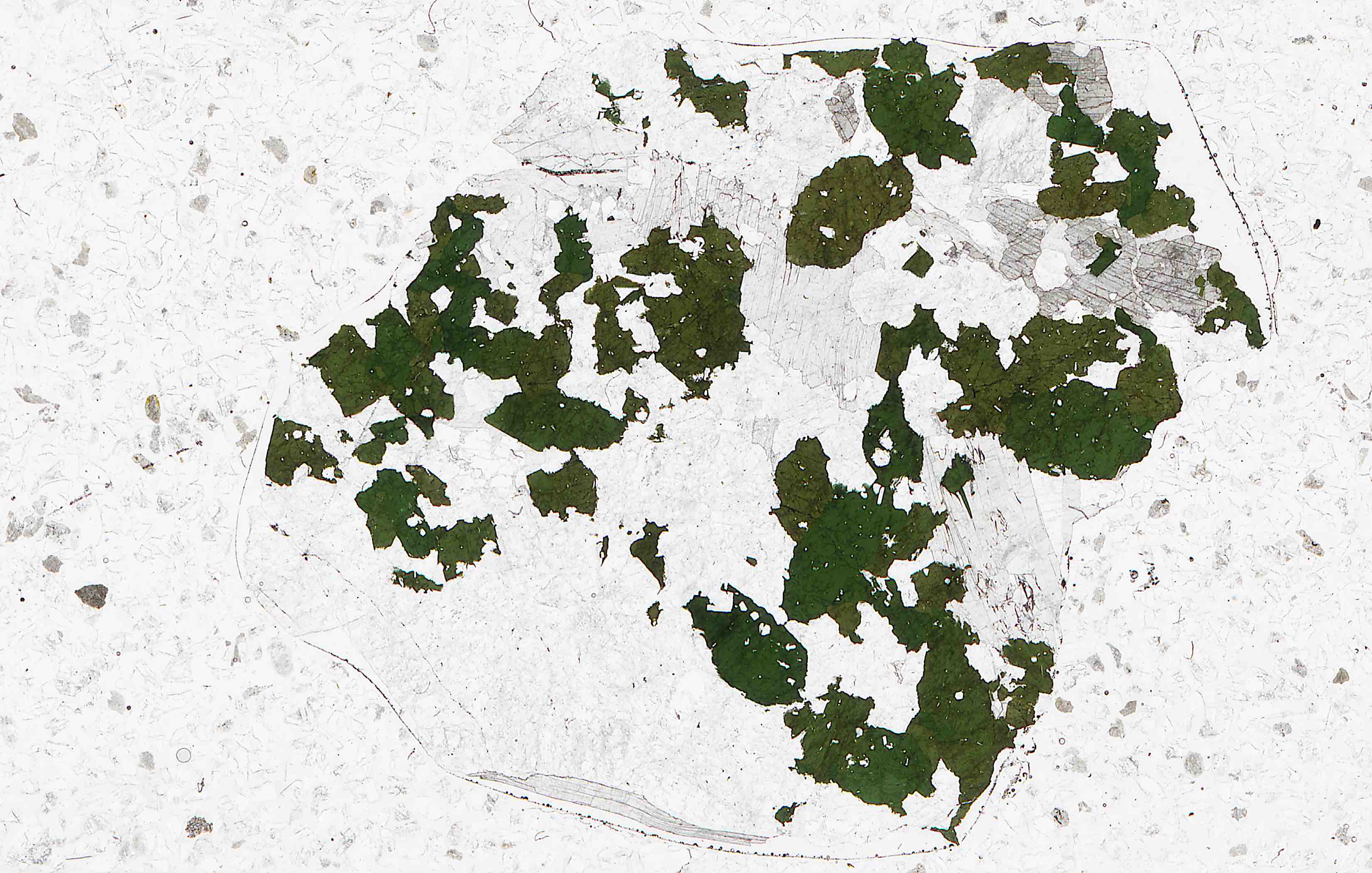

upper left image: unpolarized light; upper right image: under crossed polarizers; use slider in center to view more of either image

sample: FKM-278
locality: Dara-i-Pioz Massif, Tajikistan.
rock type: test.
major mineralogy: specimen acquired for baratovite.
accompanying videos: Short videos featuring the mineral associations and optical properties of the baratovite in this thin section offer a more detailed look at this sample.
| mineral | PPL (lower polar rotation) |
PPL (stage rotation) |
XP (stage rotation) |
optic figure (stage rotation) |
|---|---|---|---|---|
| baratovite PPL: pale buff-pink, moderate-high relief; XP: up to 1st order gray δ, but masked by strong anomalous deep blue/brown overtones; with aegirine, quartz and albite |
||||


upper left image: unpolarized light; upper right image: under crossed polarizers; use slider in center to view more of either image
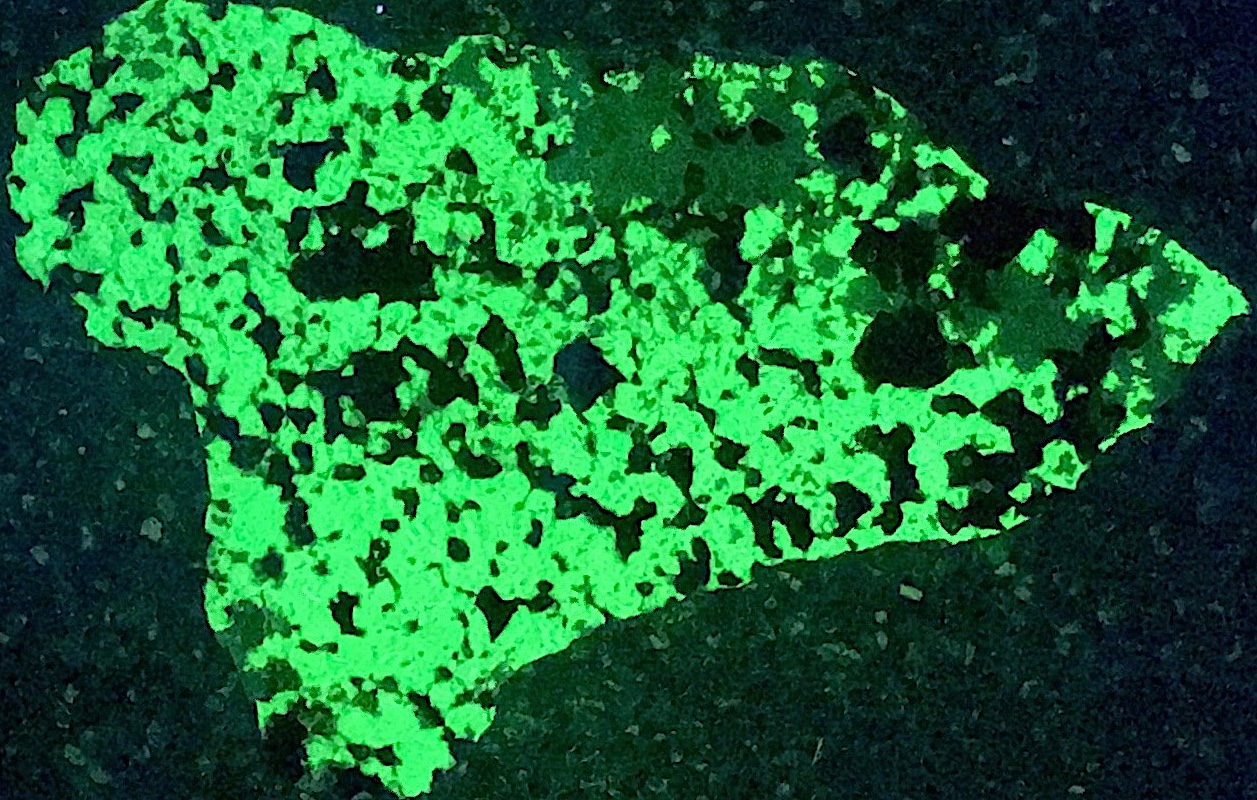
sample: FKM-279
locality: Sterling Hill, Franklin mining district, Sussex Co., NJ, USA.
rock type: test.
major mineralogy: specimen acquired for sussexite and franklinite.

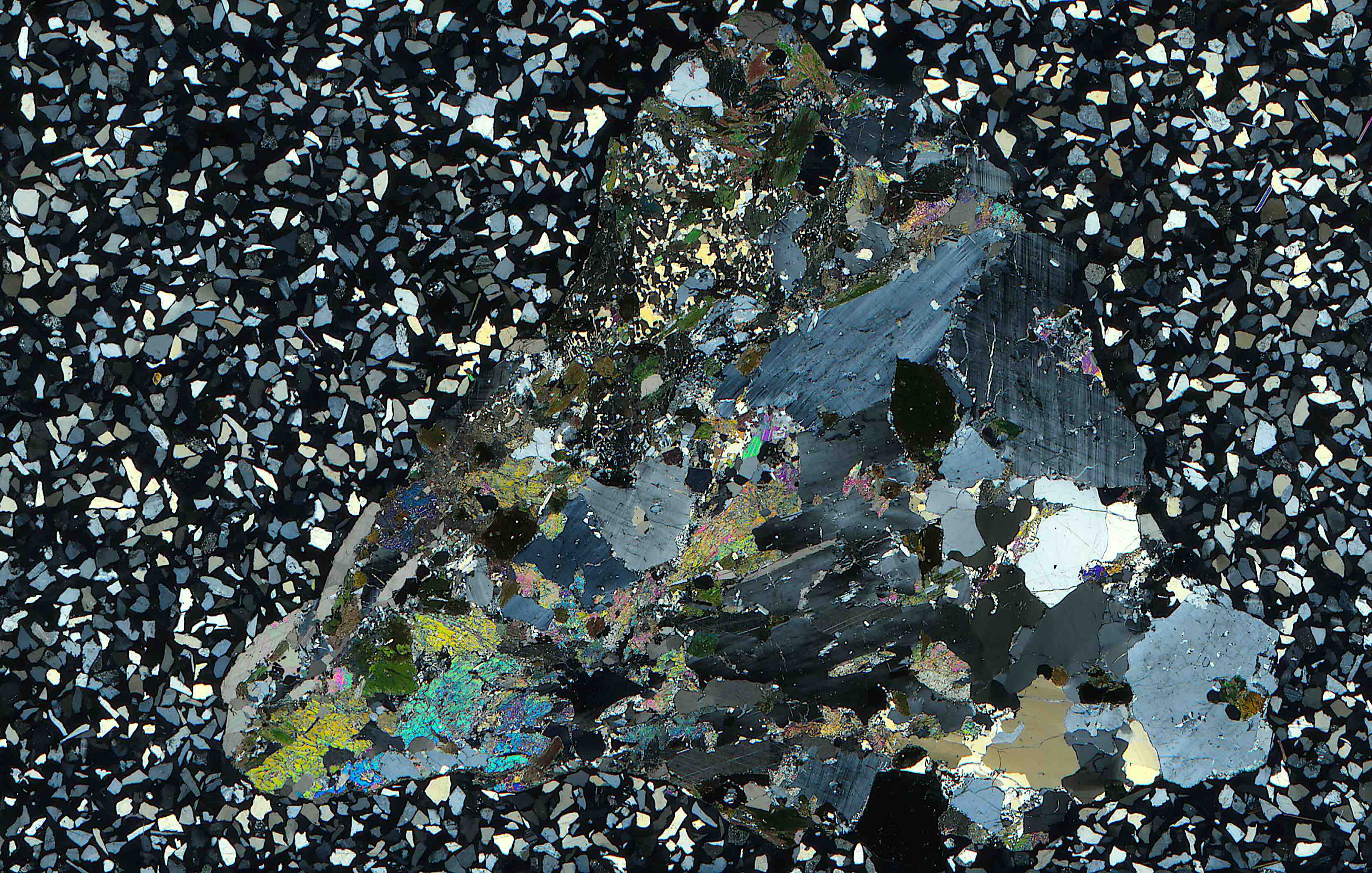
left image: unpolarized light; right image: under crossed polarizers; use slider in center to view more of either image
sample: FKM-280
locality: Dara-i-Pioz Massif, Tajikistan.
rock type: test.
major mineralogy: specimen acquired for turkestanite.


left image: unpolarized light; right image: under crossed polarizers; use slider in center to view more of either image
sample: FKM-281
locality: Uvil’dy Lake, Karabash, Chelyabinsk Oblast’, Southern Urals, Russia.
rock type: the sample is essentially a tourmaline-bearing alkali granite. The website webmineral.ru [← in Russian] describes the locality as a small pegmatite-hosted dumortierite+schorl mine developed in 1990, ostensibly to study the mineralogy of pegmatitic cordierite (the presence of which was not confirmed), on the site of an earlier trench dug in the late 1800s.
major mineralogy: specimen acquired for olenite.
| mineral | representative mineral compositions in FKM-281 |
|---|---|
| zircon | not analyzed (see text) |
| holtite (most As+Sb-rich?) | analysis pending |
| holtite (most Ti-rich?) | analysis pending |
| oxy-schorl-dominant tourmaline ss (pale blue to pale blue-green main core of large video crystal; Fe3+/∑Fe ➔ 0.10; Li ➔ 0.00 apfu) |
(Na0.55K0.01□0.44)(Fe2+1.13Al0.87Mg0.61Mn2+0.18Fe3+0.13Zn0.06Ti0.02)Al6.00 [Si5.97Al0.03O18](BO3)3(OH)3(O0.56[OH]0.35F0.09) |
| oxy-schorl-dominant tourmaline ss (deep blue to pale blue-green rim of large video crystal; Fe3+/∑Fe ➔ 0.10; Li ➔ 0.00 apfu) |
(Na0.64K0.01□0.35)(Fe2+1.13Al0.91Mg0.54Mn2+0.20Fe3+0.13Zn0.06Ti0.02)Al6.00 [Si5.98Al0.02O18](BO3)3(OH)3(O0.71[OH]0.17F0.12) |
| “oxy-olenite”-dominant tourmaline ss (thin near-edge rim of large video crystal, only discernible in BSE; Fe3+/∑Fe ➔ 0.10; Li ➔ 0.00 apfu) |
(Na0.60K0.01Ca0.01□0.38)(Al1.59Fe2+0.70Mg0.31Mn2+0.29Fe3+0.08Zn0.02Ga0.01)Al6.00 [Si5.60Al0.40O18](BO3)3(OH)3(O0.89[OH]0.11) |
| “oxy-olenite”-dominant tourmaline ss (very pale blue to nearly colorless zone of small lower-left crystal; Fe3+/∑Fe = 0.00; Li ➔ 0.00 apfu) |
(Na0.56Ca0.01□0.43)(Al1.66Mn2+0.60Fe2+0.56Mg0.09Zn0.06Ti0.01Ga0.01)Al6.00 [Si5.77Al0.23O18](BO3)3([OH]2.93O0.07)(O0.89F0.11) |
| orthoclase[?] (rim between video tourmalines) |
(K0.91Na0.07)[Si3.00Al0.99Fe3+0.01O8] |
| “perthite” (orthoclase to microcline[?] host) |
(K0.82Na0.15)[Si3.00Al1.00O8] |
| “perthite” (albite lamellae) | (Na0.95K0.01)[Si3.00Al1.00O8] |
| quartz | not analyzed |
accompanying videos: Short videos featuring the mineral associations and optical properties of the oxy-schorl/”oxy-olenite” tourmaline in this thin section offer a more detailed look at this sample.
| mineral | PPL (lower polar rotation) |
PPL (stage rotation) |
XP (stage rotation) |
optic figure (stage rotation) |
|---|---|---|---|---|
| oxy-schorl/”oxy-olenite” PPL: bluish-green/inky-blue pleochroism, moderate-high relief; XP: up to 2nd order green δ; with quartz and K-feldspar |
||||

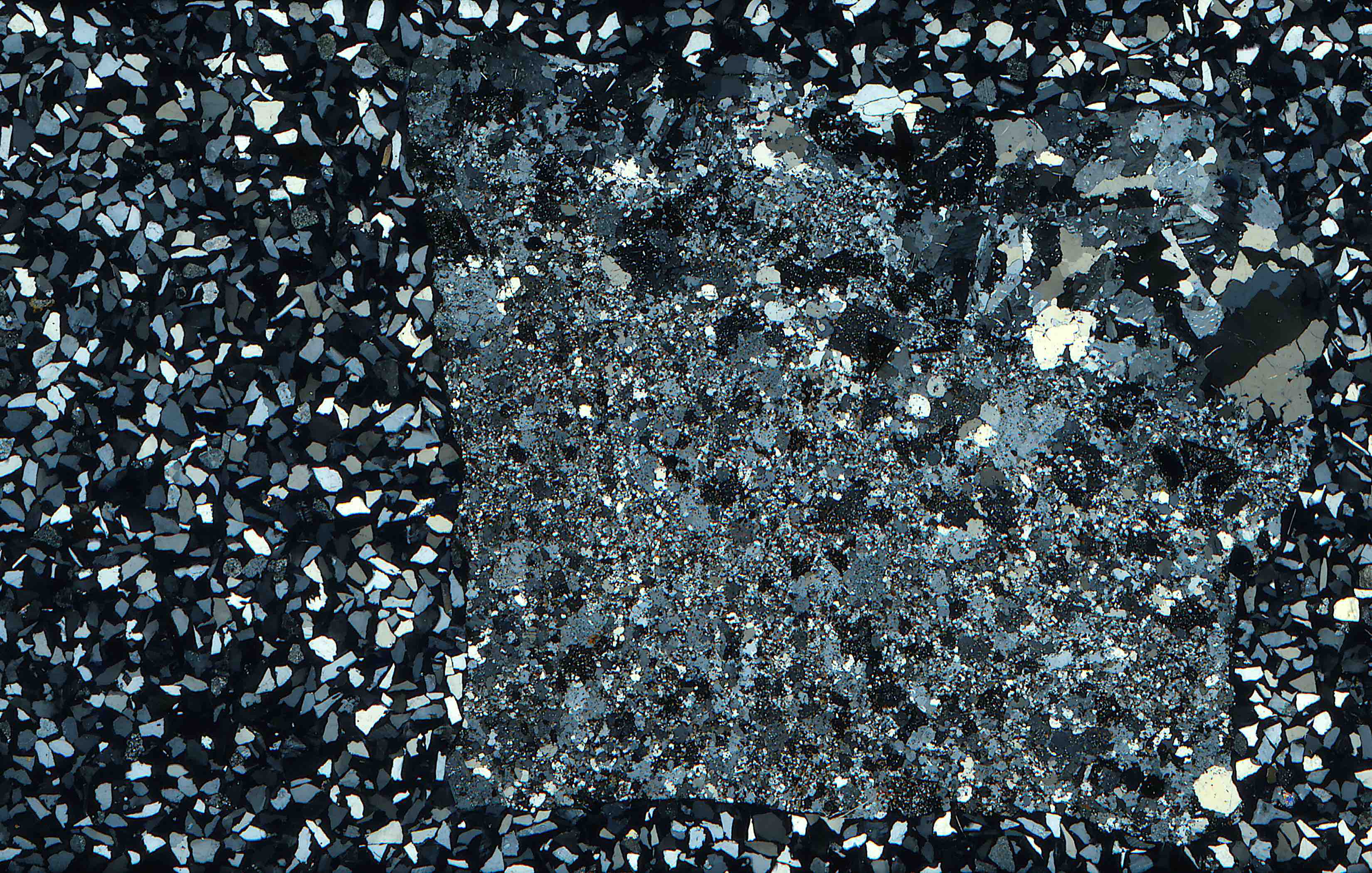
left image: unpolarized light; right image: under crossed polarizers; use slider in center to view more of either image
sample: FKM-282
locality: the locality is generalized as simply “Eikern”, Buskerud, Norway. However, with further examination of the observed mineral assemblage, including the occurrence of a pyrochlore group mineral, a gadolinite group mineral, and löllingite in addition to the anticipated genthelvite, the more specific locality of the Bakstevalåsen pegmatite, in the Eikern region, appears consistent with this sample.
rock type: The sample is a quite fine-grained alkali granite and may represent a chilled margin phase.
major mineralogy: a large portion of the sample is a quite fine-grained mixture of quartz, plagioclase and orthoclase, along with scattered very small “biotite” (FeT>Mg, with detectable Zn, Mn and Cr). Gradational to this very fine-grained part of the rock is a slightly coarser intergrowth of plagioclase (“oligoclase”; near albite composition boundary) and larger orthoclase (some showing a weakly-developed microperthitic texture with sparse “beads” of presumably albite). Minor very small biotite is also present in this portion of the rock. Poikiolitic tetrahedra of weakly-zoned genthelvite (and what appear to be some elongate slices) are very abundant in the slightly coarser portion of the rock, but sparse in the finer-grained portion. A variety of small sparse additional accessory phases are present. These include fluorite, very tiny grains of galena (some perhaps a bit oxidized towards anglesite), löllingite and fluorcalciopyrochlore. Also present is minor small zircon, showing evidence of a significant Hf content (an EDS spectrum of the zircon shows an Hf Mα shoulder of ~25% of the height of the adjacent Si Kα peak, and a concomitant notable Hf Lα peak at higher energy). Also of note in this sample is a minor amount of an [Y+HREE]-rich gadolinite group mineral; the Yb Mα peak in particular was notable in an EDS spectrum of the mineral. Normalization of this phase proved to be a significant challenge, due to known but non-measured Be, the possibility of non-measured B (here presently assumed to be zero, for simplicity), an unknown OH:O ratio, and an observed but difficult-to-quantify HREE content. Two normalization schemes were tested: (1) ∑(T1+T2+A)=5 (so excluding the potentially vacant M-site), and (2) ∑(T1)=2 (essentially forcing Si=2 apfu). In both cases, sufficient estimated Be was added to fill the T2-site (normalization scheme 2) or to fill the T2-site and offer excess to fill the T1-site (normalization scheme 1). Additionally, in both cases, Fe3+/∑Fe was assigned 0.00, and the non-measured HREE content was estimated by modeling the chondrite-normalized REE trend beyond measured Gd such that combined [estimated Be]+[estimated HREE] brings the measured analytical total as close to 100 wt% as possible while maintaining overall charge balance. Normalization scheme 2 fails because the A-site significantly overfills while the overall total is significantly below 100 wt%. Normalization scheme 1 does satisfy all the criteria (and this scheme is utilized to derive the formula in the table below), but requires that ~10 atom% of the T1-site is Be; whether this is realistic is not known in this case (although Si substitution in the Be site has been demonstrated by a structure determination of a “Ca-hingganite-(Y)”: Cooper et al., 2019 [← subscription required]). The outcome of this normalization is that while the mineral is a gadolinite group phase, it may be a new end-member, representing either an OH-dominant gadolinite-(Y) or an Fe2+-dominant hingganite-(Y). Such a phase is already reported from another Norwegian pegmatite (see “OH-analogue of gadolinite-(Y)”).
| mineral | representative mineral compositions in FKM-282 |
|---|---|
| galena (v. small grain) | (Pb0.99Mn0.01?)S1.00 |
| löllingite | (Fe0.97Ni0.03Co0.01)As1.99 |
| fluorcalciopyrochlore | (Ca1.26Na0.43Th0.04Mn2+0.01□0.26?) (Nb1.42Ti0.33Ta0.17?Sn0.05FeT0.02)(O5.74[OH]0.26?)(F0.53[OH]0.47) |
| fluorite | not analyzed |
| zircon | not analyzed (see text) |
| “OH-dominant gadolinite-(Y)” (see Chukanov et al., 2017) |
(Y0.85Ca0.67[Yb+HREE]~0.22Th0.10Ce0.07La0.04Gd0.03Nd0.01Pr0.01) (Fe2+0.64Mn2+0.01□0.35)Be2.00[Si0.905Be0.095O4]2([OH]1.63O0.37) |
| “biotite” | (K0.87Na0.01□0.12)(FeT1.40Mg1.22Ti0.18Al0.06Zn0.04Mn2+0.04Cr0.01□0.05)[Si3.00Al1.00O10]([OH]0.90F0.71O0.36Cl0.04) |
| quartz | not analyzed |
| orthoclase | (K0.92Na0.05)[Si3.01Al0.99O8] |
| “oligoclase” (coarse) | (Na0.89Ca0.12K0.01)[Si2.91Al1.09O8] |
| genthelvite (core of video crystal; most Fe-rich) | (Zn2.35Fe2+1.28Mn2+0.40Mg0.01)[Si2.98Be~2.95P0.01O12]S1.00 |
| genthelvite (core of elongate slice; most Mn-rich) | (Zn2.34Fe2+1.13Mn2+0.52Mg0.01)[Si3.01Be~2.97P0.01O12]S1.00 |
| genthelvite (rim of elongate slice; most Zn-rich) | (Zn2.91Fe2+0.76Mn2+0.32Mg0.01)[Si3.00Be~2.86Zn0.13?P0.01O12]S0.99 |
accompanying videos: Short videos featuring the mineral associations and optical properties of the genthelvite in this thin section offer a more detailed look at this sample.
| mineral | PPL (lower polar rotation) |
PPL (stage rotation) |
XP (stage rotation) |
optic figure (stage rotation) |
|---|---|---|---|---|
| genthelvite PPL: tan, high relief; XP: isotropic; with albite, orthoclase and biotite |
isotropic | |||
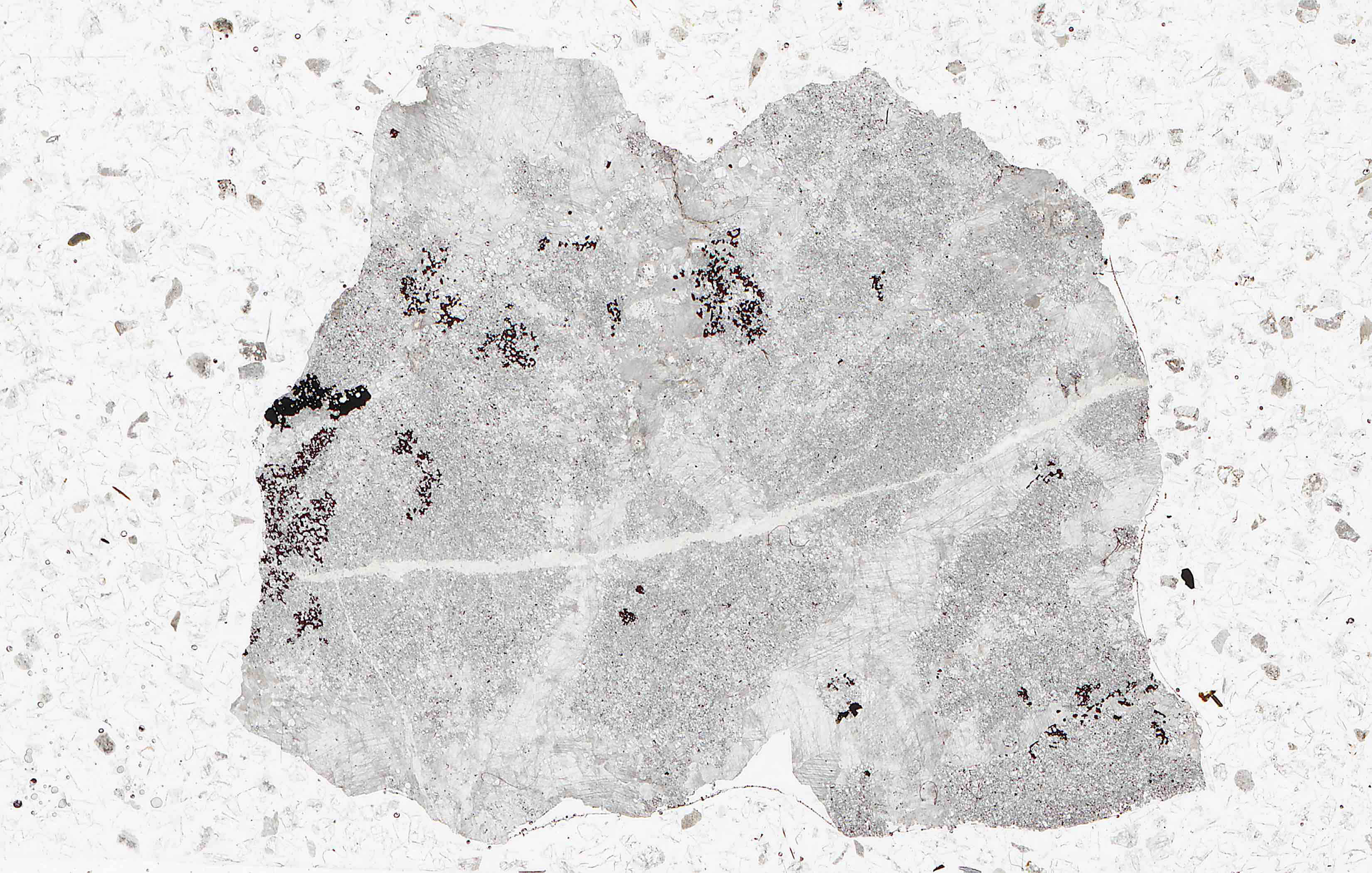
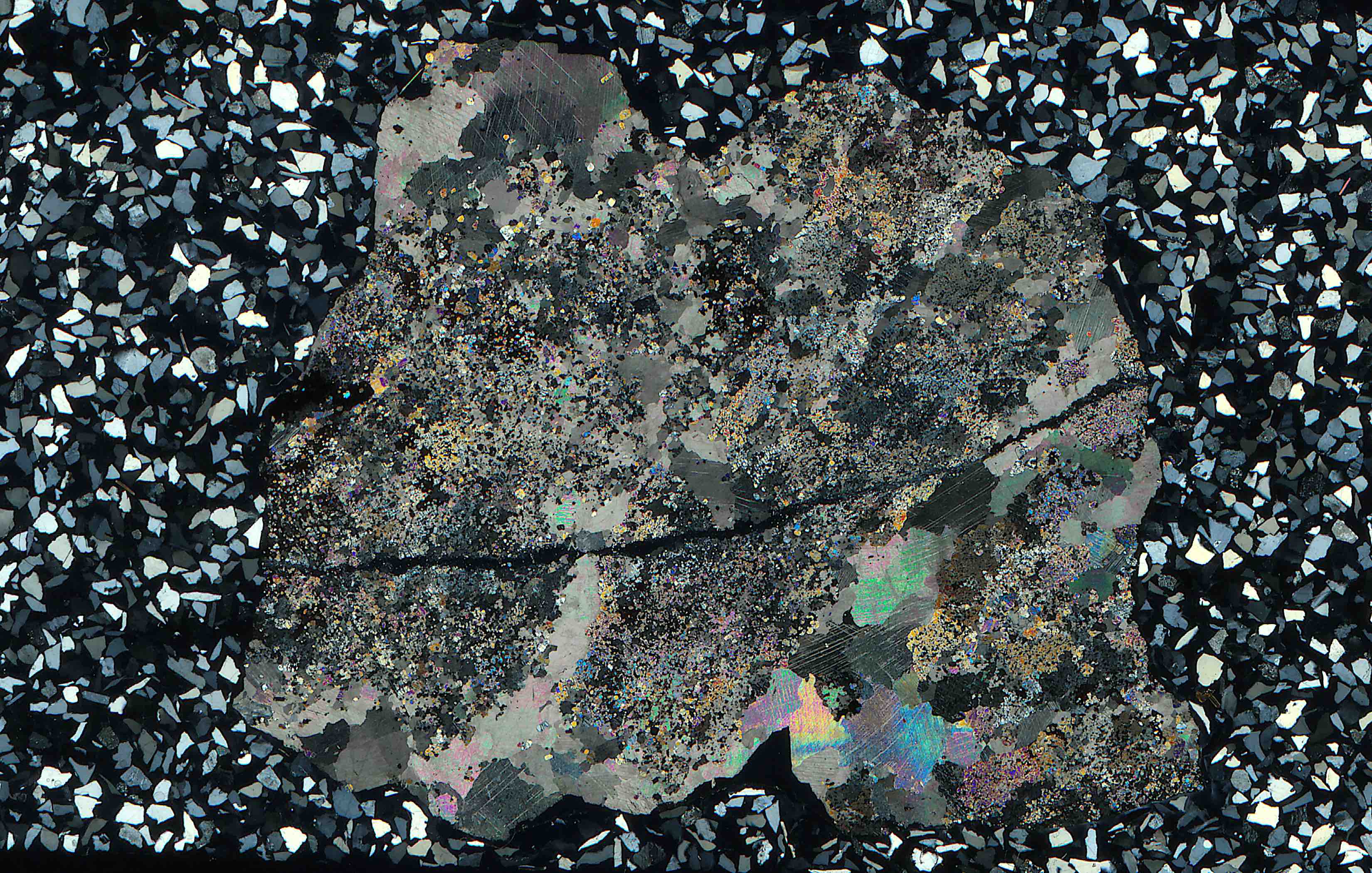
left image: unpolarized light; right image: under crossed polarizers; use slider in center to view more of either image
sample: FKM-283
locality: Tazheranskii Massif, Lake Baikal area, Irkutskaya Oblast’, Prebaikalia, Eastern-Siberian Region, Russia.
rock type: presumably a high-grade magnesian marble, although some (see the locality description at the link above) have speculated that the abundance of HFSE (Ti, Zr and particularly Nb) minerals suggests the “marble” may actually be a carbonatite. Alkali syenite and nepheline syenite are reported in the area.
major mineralogy: Calcite, spinel and forsterite make up the sample; the forsterite crystals are variably veined with serpentine, and a larger serpentine vein cuts the entire sample. From the XP scan image, much of the forsterite appears to form larger irregular crystals heavily included with spinel; some of these crystals are especially notable in the SE corner of the sample. However, these apparently larger crystals are actually clusters of small optically-continuous individual crystals (note the consistent birefringence), with the spinel abundantly interspersed within the forsterite clusters, in a relationship somewhat reminiscent of a “vuggy” symplectite. No relict dolomite was observed in the sample. A variety of accessory oxide minerals are present. Geikielite (for which the specimen was acquired) is fairly abundant, also forming scattered clusters of crystals throughout the sample. Magnetite, in part altering to “limonite”, occurs as a few larger grains; in one example, several grains of Co-bearing pentlandite were found included within the magnetite. One rounded Ti-Mg-oxide not associated in a cluster, first thought to be an atypical occurrence of isolated geikelite, instead normalized to qandilite, and more grains of the mineral are likely present. Calzirtite crystals are scattered in the sample, and some of the crystals are zoned in U. Based on EPMA-measured U, Th and Pb in two high-U examples, the average “chemical age” of the calzirtite is roughly 405 Ma (pt. 76: U = 17280 ppm, Th = 200 ppm, Pb = 1050 ppm, age ~420 Ma; pt. 63: U = 15060 ppm, Th = 240 ppm, Pb = 860 ppm, age ~390 Ma); this is consistent with two reported K-Ar ages of between 350 Ma and 430 Ma from the associated syenite [Konev, A.A. (1969) The Tezheran Massif of gabbro, alkali and nepheline syenites. In EP Pavlovsky (ed.), Geology of the Baikal Region, p.121. Institute of the Earth’s Crust, Irkutsk]. One larger fluorapatite crystal was also observed.
| mineral | representative mineral compositions in FKM-283 |
|---|---|
| pentlandite | (Fe3.62Ni3.13Co2.21)S8.03 |
| geikielite | (Mg0.94Fe2+0.04)(Ti1.00V0.01)O3 |
| qandilite | (Ti0.89Fe3+0.05Al0.03V0.03)(Mg1.69Fe2+0.19Al0.10Mn2+0.02)O4 |
| magnetite | (Fe2+0.95Mg0.05Ni0.01)(Fe3+1.98Si0.01)O4 |
| spinel | (Mg0.99Fe2+0.01)(Al1.97Fe3+0.01Ti0.01)O4 |
| “limonite” | not normalized; Fe: 64.7 wt%, Mg: 1.3 wt%; Ni: 0.2 wt%; Ca: 0.1 wt%; Si: 0.1 wt% |
| calzirtite (main; lower z) |
(Ca1.96Ba0.01Sr0.01U0.01)(Zr4.88Hf~0.05Ti0.07)(Ti1.98V0.02Sc0.01)O16 |
| calzirtite (rim; higher z) |
(Ca1.91U0.07Fe0.01)(Zr4.95Hf~0.05)(Ti1.97V0.02Sc0.01Al0.01)O16 |
| calcite | (Ca0.95Mg0.05)[CO3] |
| fluorapatite | Ca4.99[P0.997Si0.003O4]3(F0.60[OH]0.40) |
| forsterite | Mg0.99(Mg0.99Fe2+0.01)[Si1.00O4] |
| “serpentine” | (Mg5.77Al0.06Ti0.02FeT0.01□0.14)[Si4.04O10]([OH]7.97O~0.03) |


left image: unpolarized light; right image: under crossed polarizers; use slider in center to view more of either image
sample: FKM-284
locality: Titovskoe boron deposit, Tas-Khayakhtakh Range, Dogdo River Basin, Polar Yakutia, Sakha Republic, Eastern-Siberian Region, Russia.
rock type: test.
major mineralogy: specimen acquired for olshanskyite. A specimen of very similar appearance from Pavel Kartashov’s collection (minID: PMQ-G3U) is described as grayish olshanskyite veinlets rimmed by secondary hydrous calcium borates within massive sakhaite, accompanied by magnetite. In advance of any potential microprobe work (challenging due to the abundance of light elements in most of these minerals and also their likely extreme beam sensitivity), this mineral assemblage is petrographically consistent with the observed optical properties of the minerals in this thin section. Sample FKM-254 is a similar frolovite-bearing calcium-borate skarn from the Solongo boron deposit.
accompanying videos: Short videos featuring the mineral associations and optical properties of the olshanskyite and sakhaite in this thin section offer a more detailed look at this sample.
| mineral | PPL (lower polar rotation) |
PPL (stage rotation) |
XP (stage rotation) |
optic figure (stage rotation) |
|---|---|---|---|---|
| olshanskyite PPL: colorless, low relief; XP: up to 1st order orange δ; with sakhaite and additional borates |
||||
| sakhaite PPL: colorless, moderate relief; XP: isotropic; with olshanskyite and additional borates |
isotropic | |||
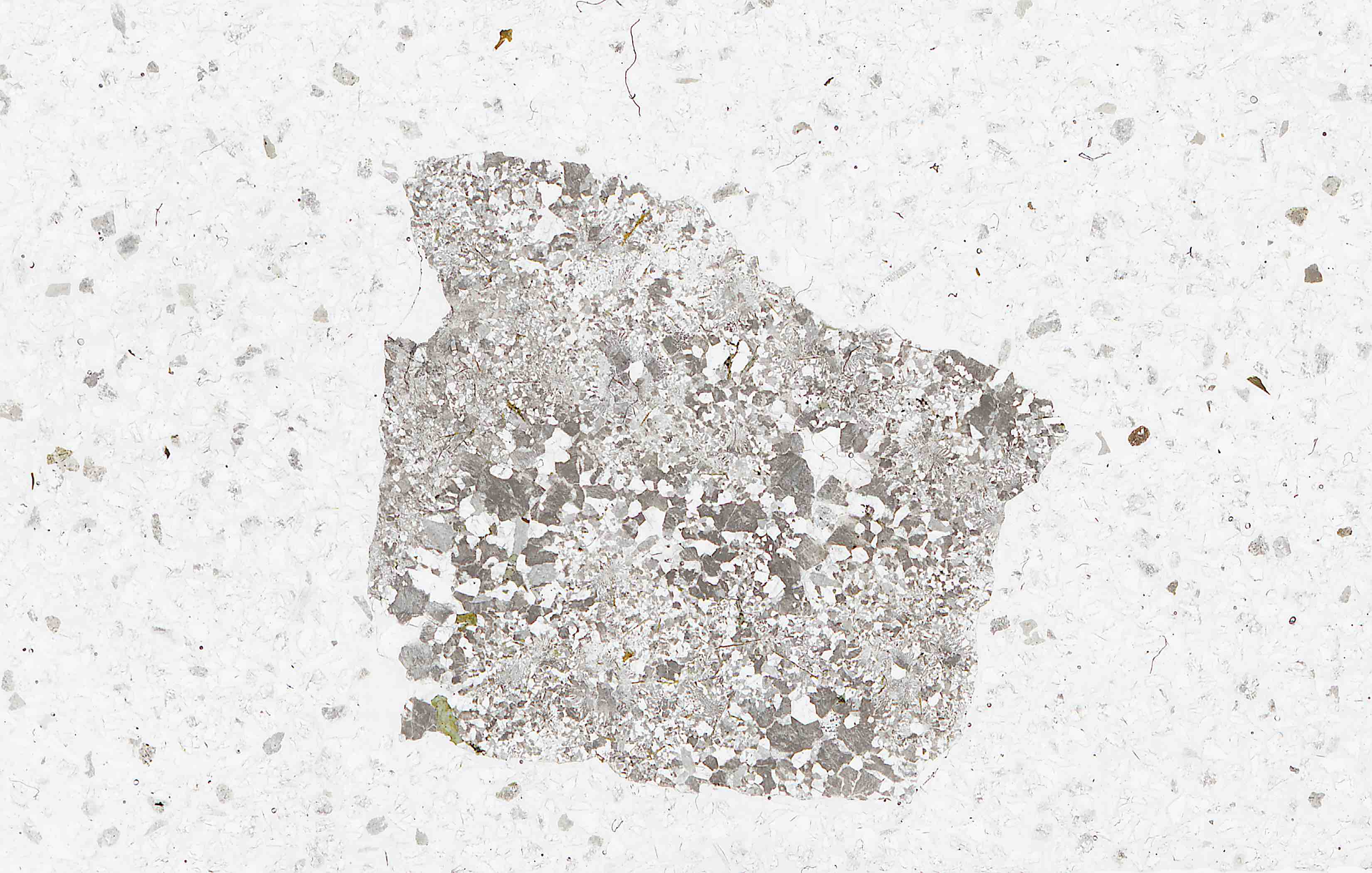
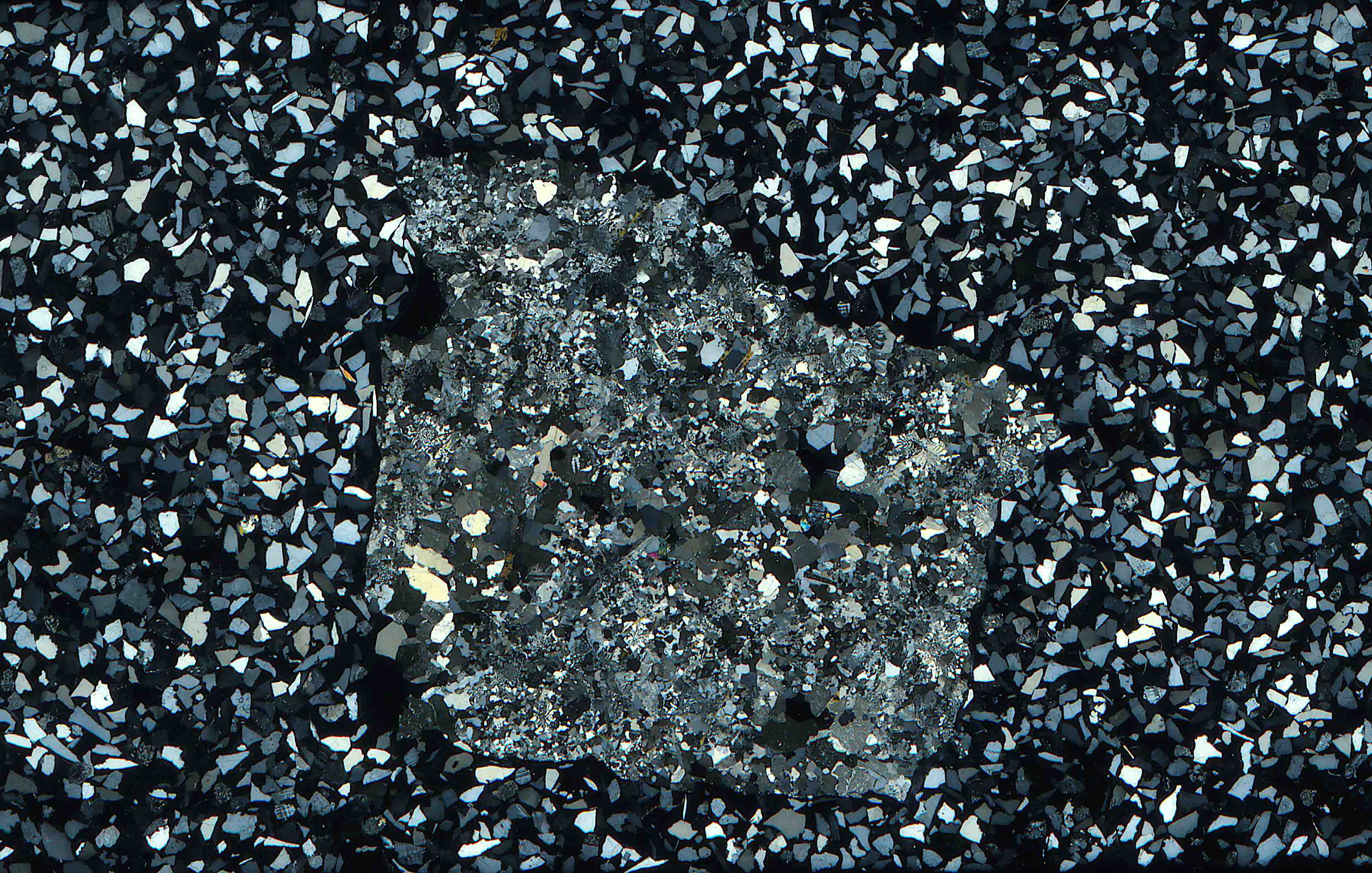
left image: unpolarized light; right image: under crossed polarizers; use slider in center to view more of either image
sample: FKM-285
locality: Seula mine (ex Montecatini quarry), Mount Camoscio, Oltrefiume, Baveno, Verbano-Cusio-Ossola Province, Piedmont, Italy.
rock type: test.
major mineralogy: specimen acquired for polycrase-(Y), aeschynite-(Y) and fluorite.
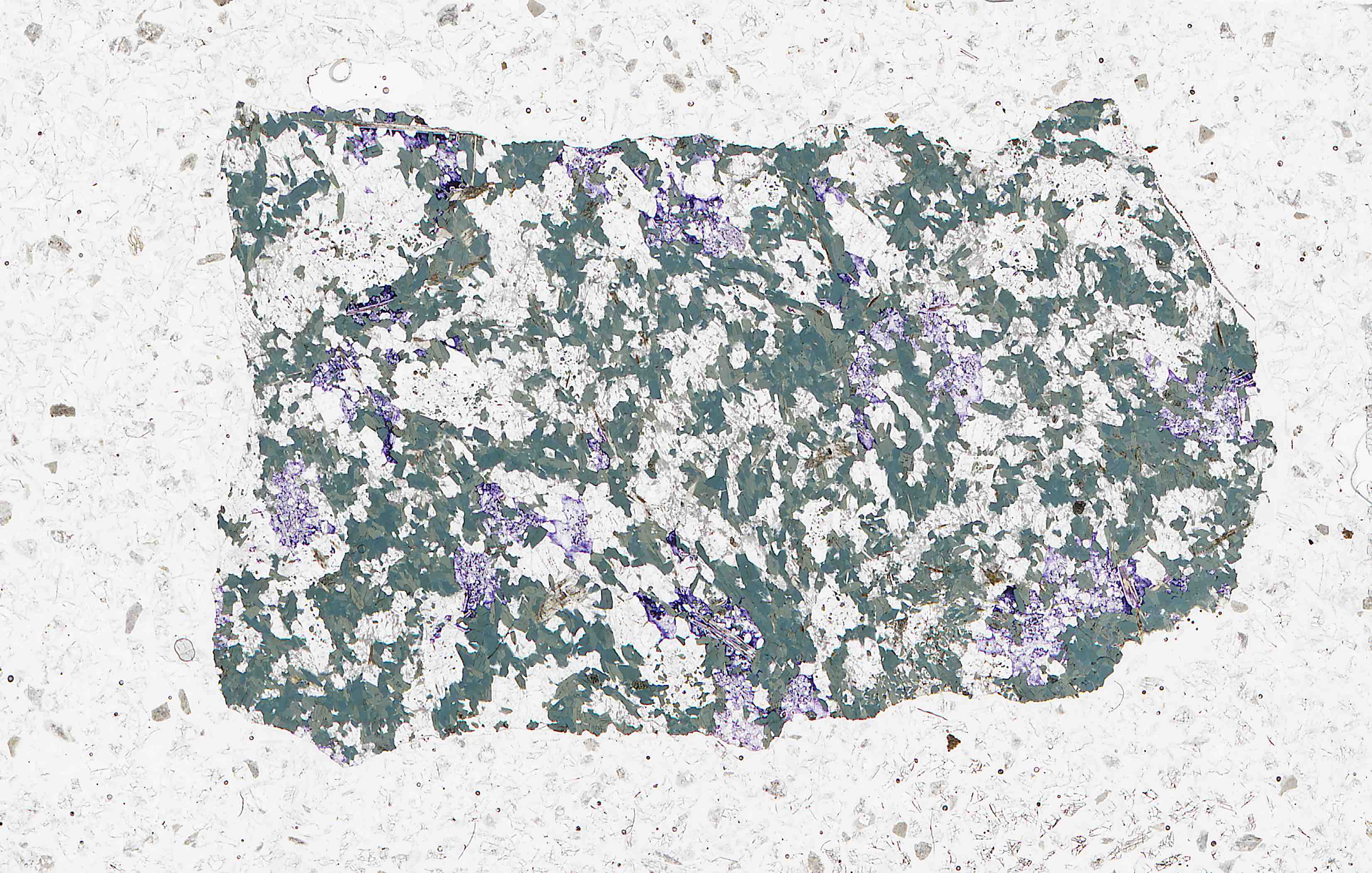

left image: unpolarized light; right image: under crossed polarizers; use slider in center to view more of either image
sample: FKM-286
locality: Norra Kärr, Gränna, Jönköping, Småland, Sweden.
rock type: test.
major mineralogy: specimen acquired for rosenbuschite. This specimen appears to be essentially identical to sample FKM-146, from the same locality.


left image: unpolarized light; right image: under crossed polarizers; use slider in center to view more of either image
sample: FKM-287
locality: the locality is given on the dealer label as “Gratinern Hill, Ontario, Canada”, but this locality does not appear to exist.
rock type: test.
major mineralogy: specimen acquired for kornerupine.

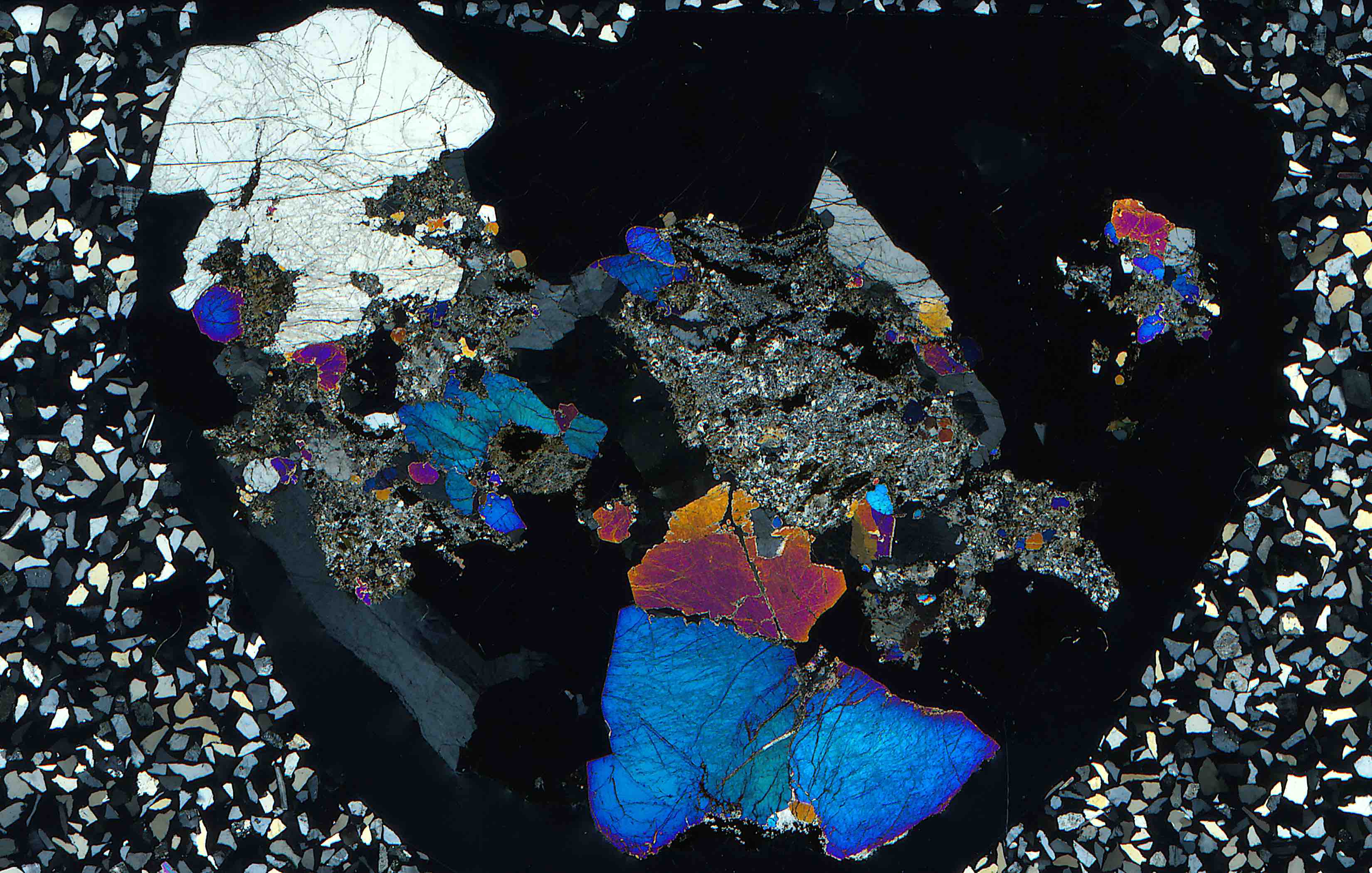
left image: unpolarized light; right image: under crossed polarizers; use slider in center to view more of either image
sample: FKM-288
locality: Snezhnoe Be deposit, Eastern Sayan, Buriatia, Prebaikalia, Eastern-Siberian Region, Russia.
rock type: test.
major mineralogy: specimen acquired for phenakite and fluorite.
accompanying videos: Short videos featuring the mineral associations and optical properties of the phenakite and beryl in this thin section offer a more detailed look at this sample.
| mineral | PPL (lower polar rotation) |
PPL (stage rotation) |
XP (stage rotation) |
optic figure (stage rotation) |
|---|---|---|---|---|
| phenakite PPL: colorless, moderate relief; XP: up to 2nd order blue δ; with beryl and biotite |
||||
| beryl PPL: colorless, low relief; XP: up to 1st order yellow-tinted gray δ; with phenakite, fluorite and biotite |
||||
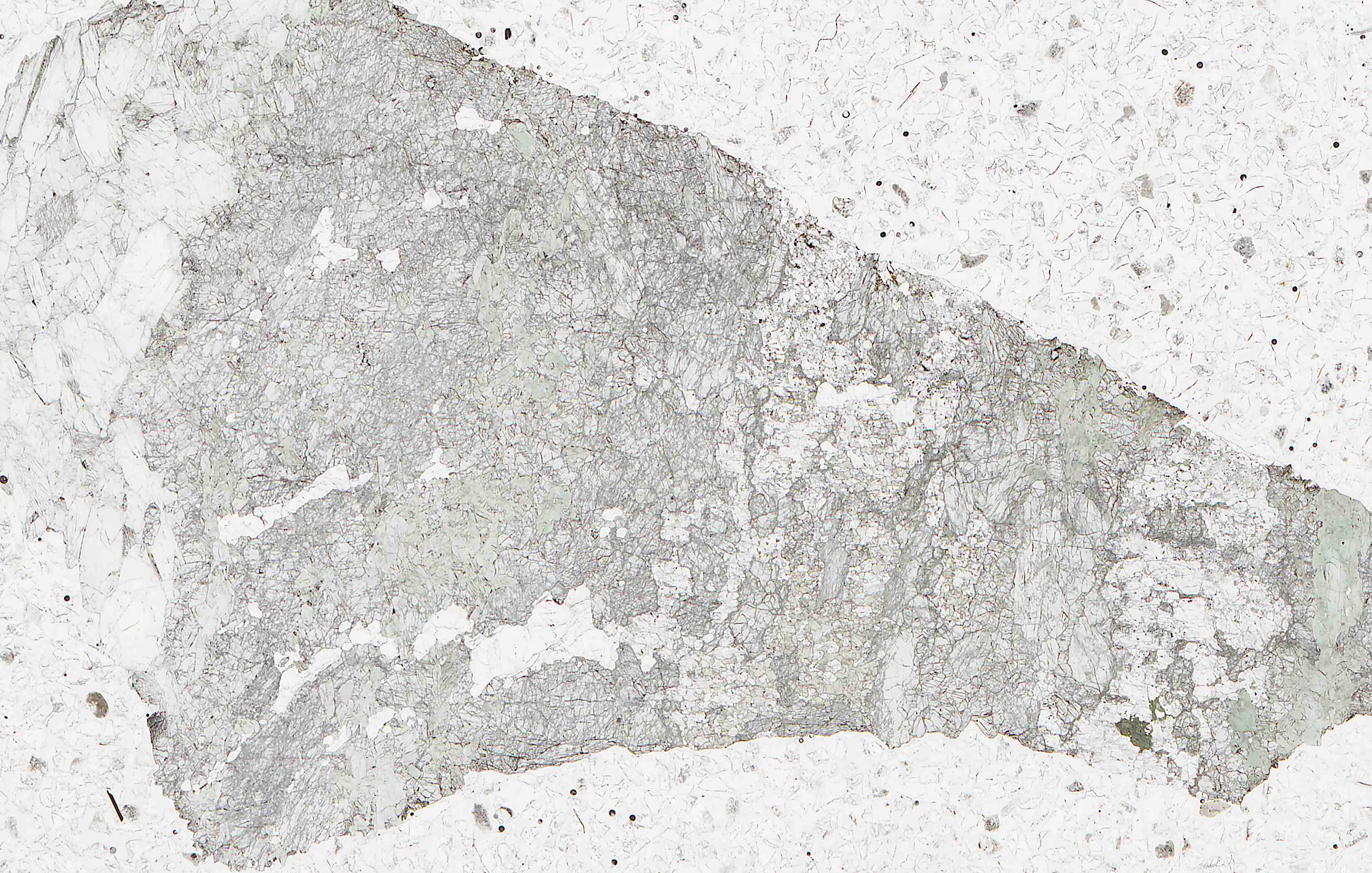

left image: unpolarized light; right image: under crossed polarizers; use slider in center to view more of either image
sample: FKM-289 (billet courtesy of S. Runyon, Univ. Wyoming)
locality: Luhr Hill, Yerington District, Lyon Co., NV, USA.
rock type: test.
major mineralogy: specimen acquired for oxy-dravite and phlogopite.

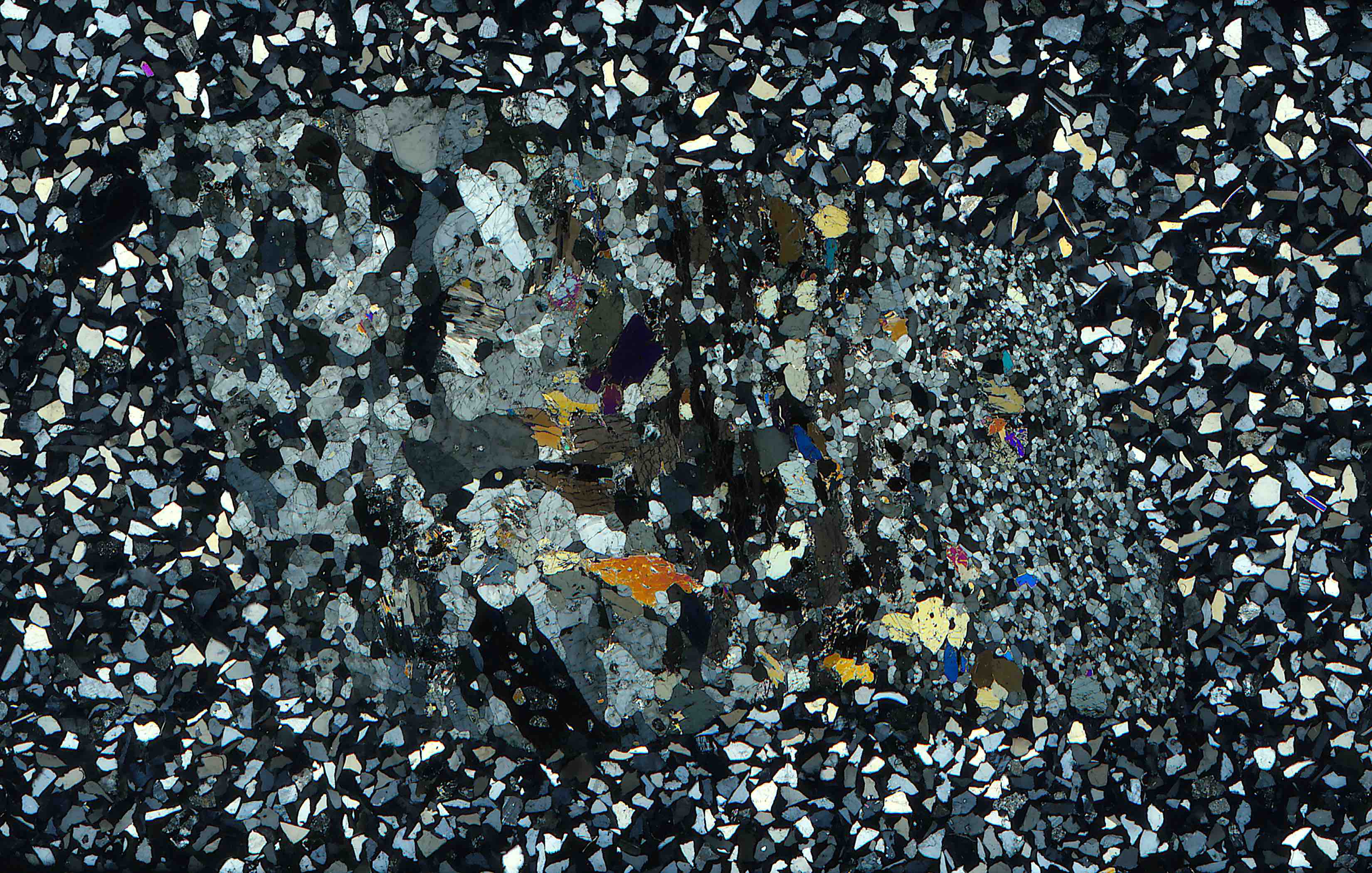
left image: unpolarized light; right image: under crossed polarizers; use slider in center to view more of either image
sample: FKM-290
locality: Mundarara Mine, Arusha Region, Tanzania.
rock type: spinel-corundum-pargasite-zoisite gneiss. Presumably a higher pressure (eclogite facies) equivalent of corundum-bearing amphibolite (i.e., akin to sample FKM-24); estimated at between 700°-850° C and between ~10-20 kbars, according to experimental phase relations. Note that unlike FKM-24, the amphibole in this sample is actually pargasite rather than tschermakite. Both this sample and FKM-24 (as well as FKM-68; see discussion below) are thus granulite to eclogite facies metamorphic equivalents of what were probably originally gabbro to gabbroic anorthosite. Unlike FKM-68, this sample shows more evidence of retrograde reaction, and also more evidence of probable relict mineralogy.
major mineralogy: On first appearance of the hand sample, made up of bright green zoisite, black amphibole (pargasite) and dark pink corundum (ruby; orange cathodoluminescence), this specimen appears ostensibly identical to the mineralogically-similar FKM-68 (see link above) presumably from Longido, ~27 km E of Mundarara; however, closer inspection of the thin section shows some notable differences between the two rocks (note however that it is possible that both samples are actually from Mundarara, and the differences in mineralogy reflect local small-scale variations in bulk protolith composition, in temperature, or in metasomatic effects). Mixed composition spinel-group minerals form relatively large grains and are abundant in this sample, ranging in nature from transparent green chromian spinel to darker chromian hercynite and opaque chromite. Clinochlore occurs abundantly with the amphibole and zoisite, and is locally associated with patches of zoned epidote/clinozoisite and sparse titanite. Minor amesite occurs primarily with the spinels, and a minor potential “Al-interlayer vermiculite” sheet silicate (“clay”) is also present.
| mineral | representative mineral compositions in FKM-290 |
|---|---|
| spinel-dominant spinel group ss (most Al-rich) |
(Mg0.51Fe2+0.48Mn2+0.01)(Al1.83Cr0.17)O4 |
| spinel-dominant spinel group ss (most Cr-rich) |
(Mg0.51Fe2+0.47Mn2+0.01)(Al1.75Cr0.23Fe3+0.02)O4 |
| hercynite-dominant spinel group ss (most Al-rich) |
(Fe2+0.57Mg0.40Mn2+0.01Zn2+0.01)(Al1.75Cr0.23Fe3+0.02)O4 |
| hercynite-dominant spinel group ss (most Cr-rich) |
(Fe2+0.87Mg0.07Mn2+0.03Zn2+0.02)(Al0.96Cr0.93Fe3+0.10)O4 |
| chromite-dominant spinel group ss (most Al-rich) |
(Fe2+0.85Mg0.09Mn2+0.05Zn2+0.01)(Cr0.98Al0.91Fe3+0.10)O4 |
| chromite-dominant spinel group ss (most Cr-rich) |
(Fe2+0.88Mg0.06Mn2+0.04Zn2+0.02)(Cr1.12Al0.77Fe3+0.11)O4 |
| corundum | (Al1.99Cr0.01)O3 |
| titanite | Ca0.99(Ti0.88Al0.10Fe3+0.01Cr0.01)(O0.88[OH]0.11)[Si1.00O4] |
| zoisite | Ca1.00(Ca0.98Sr0.01)Al1.00Al1.00(Al0.92Fe3+0.06Cr0.02)O1.00[Si2.00O7][Si0.98Al0.01P0.01O4](OH) |
| clinozoisite-dominant epidote group ss (most Al-rich) |
Ca1.00(Ca0.99Sr0.01)Al1.00Al1.00(Al0.66Fe3+0.29Cr0.03Ti0.01)O1.00[Si2.00O7][Si0.99Al0.01O4](OH) |
| clinozoisite-dominant epidote group ss (most Cr-rich) |
Ca1.00(Ca0.96Sr0.01)Al1.01Al1.01(Al0.47Fe3+0.42Cr0.10Mn3+0.01Ti0.01)O1.00 [Si1.98Al0.02O7][Si0.99Al0.01O4](OH) |
| epidote-dominant epidote group ss | Ca1.00Ca0.99Al1.00Al1.00(Fe3+0.50Al0.48)O1.00[Si1.98Al0.02O7][Si0.98Al0.02O4](OH) |
| pargasite (Leake et al., 1997) or alternatively sadanagaite (Hawthorne et al., 2012) (most Al+Cr+FeT-rich; most strongly pleochroic) |
(Na0.84K0.12□0.04)(Ca1.95Fe2+0.03Mn2+0.02)(Mg2.67Al1.09Fe2+0.73Fe3+0.28Cr0.14Ti0.09) [Si5.52Al2.48O22]([OH]1.83O0.17) |
| pargasite (main; most Mg-rich) | (Na0.84K0.10□0.06)(Ca1.97Fe2+0.02Mn2+0.01)(Mg3.05Al1.13Fe2+0.70Cr0.07Ti0.03Fe3+0.02) [Si5.83Al2.17O22]([OH]1.95O0.05) |
| amesite | (Ca0.02Na0.01)(Mg2.88Al2.41Cr0.29FeT0.01□0.41)[Si2.06Al1.94O10]([OH]7.99O0.01) |
| clinochlore (most Mg+Si-rich) | (Mg4.17Al1.26FeT0.43Cr0.04MnT0.01Ni0.01□0.08)[Si2.82Al1.18O10](OH)8.00 |
| clinochlore (most Fe+Cr-rich) | (Mg3.43Al1.51FeT0.90Cr0.06MnT0.01□0.09)[Si2.57Al1.43O10](OH)8.00 |
| “Al-interlayer vermiculite”? | Al0.56(Mg2.98Al0.02)[Si2.23Al1.76O10]([OH]1.99Cl0.01) . 4H2O? |
accompanying videos: Short videos featuring the mineral associations and optical properties of the corundum, spinel, zoisite, pargasite and clinochlore in this thin section offer a more detailed look at this sample.
| mineral | PPL (lower polar rotation) |
PPL (stage rotation) |
XP (stage rotation) |
optic figure (stage rotation) |
|---|---|---|---|---|
| corundum (“ruby”) PPL: near-colorless/medium pink pleochroism, high relief; XP: up to 1st order pale yellow δ (a bit thick); with zoisite and epidote |
||||
| Cr-bearing spinel PPL: medium green, high relief; XP: isotropic; with pargasite, zoisite, corundum and “clay” |
isotropic | |||
| zoisite PPL: very weak pale green pleochroism, high relief; XP: up to 1st order yellow-white δ, with anomalous blue and brown overtones |
||||
| Cr-bearing pargasite PPL: pale green/medium green pleochroism, moderate-high relief; XP: up to 1st order yellow δ; with zoisite, epidote, clinochlore and spinel |
||||
| clinochlore PPL: weak pale green pleochroism, moderate relief; XP: up to 1st order yellow-white δ, with anomalous brown and blue overtones; with zoisite and epidote |
||||


left image: unpolarized light; right image: under crossed polarizers; use slider in center to view more of either image
sample: FKM-291 (self-collected)
locality: Mount Wheeler Mine, Mount Washington District, Snake Range, White Pine Co., NV, USA.
rock type: test.
major mineralogy: specimen acquired for bertrandite.
accompanying videos: Short videos featuring the mineral associations and optical properties of the bertrandite in this thin section offer a more detailed look at this sample.
| mineral | PPL (lower polar rotation) |
PPL (stage rotation) |
XP (stage rotation) |
optic figure (stage rotation) |
|---|---|---|---|---|
| bertrandite PPL: colorless, moderate relief; XP: up to 2nd order blue-green δ; with quartz and carbonate |
||||

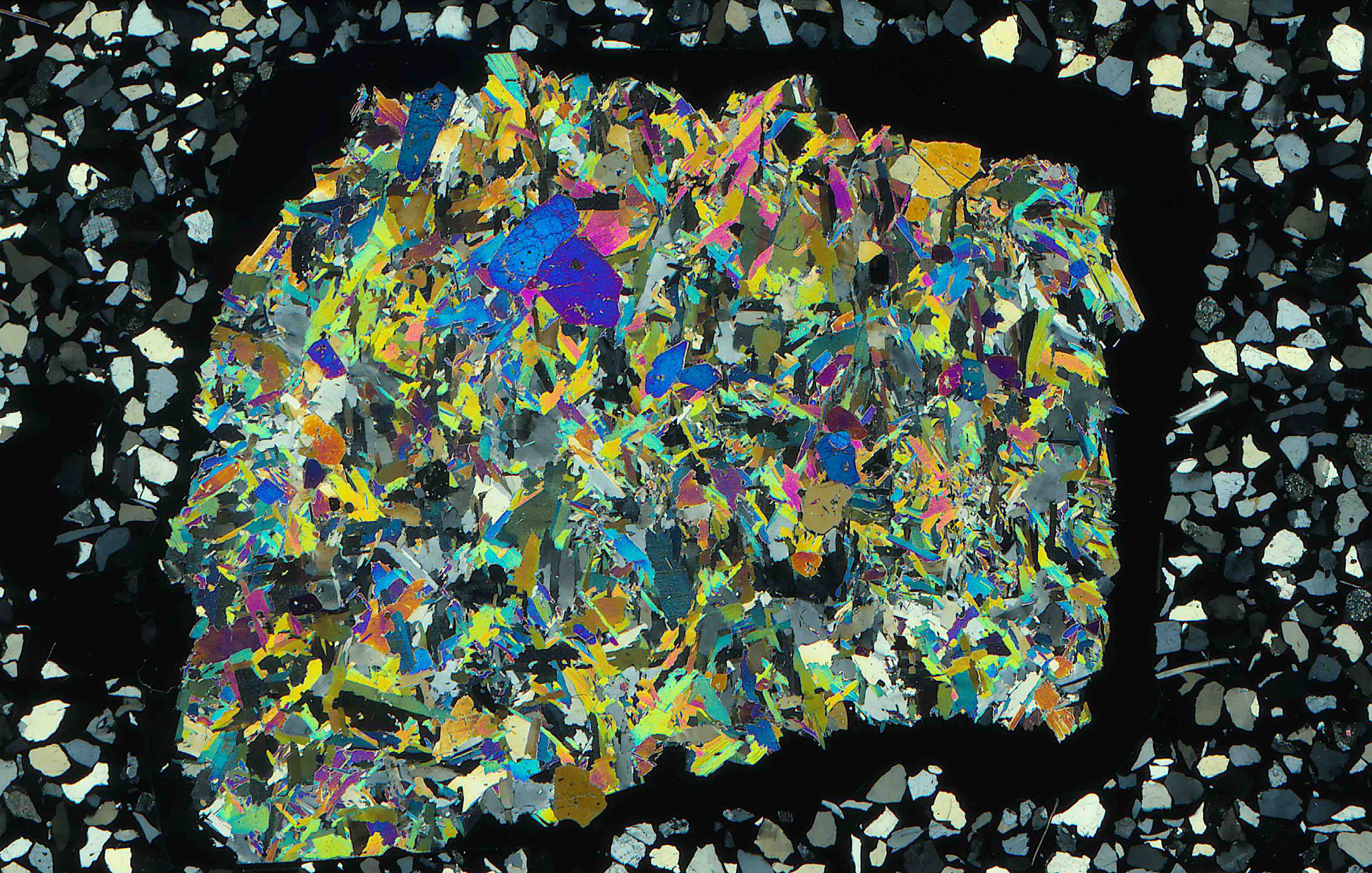
upper left image: unpolarized light; upper right image: under crossed polarizers; use slider in center to view more of either image

sample: FKM-292
locality: Dobrova, Dravograd, Slovenia (type locality for dravite).
rock type: possibly a tourmaline-muscovite schist, but the sample doesn’t have a schistose texture and the bulk chemistry and mineralogy are not typical of a meta-argillite. The sample may instead be of metasomatic origin.
major mineralogy: The specimen consists of largely randomly-oriented muscovite, with abundant idioblastic (=euhedral) crystals of essentially unzoned, nearly Fe-free dravite. The dravite contains sparse small inclusions of rutile, muscovite and paragonite, and an uncharacterized aluminum silicate polymorph. The dravite is weakly fluorescent pale yellow-orange under SWUV.
| mineral | representative mineral compositions in FKM-292 |
|---|---|
| rutile | Ti0.99O2 |
| zircon | not analyzed |
| Al2O[SiO4] polymorph | Al2.00O1.00[Si0.98Al0.02O4] |
| dravite | (Na0.73Ca0.13□0.14)(Mg2.58Al0.27Fe2+0.10Ti0.04)Al6.00[Si5.96Al0.04O18](BO3)3(OH)3([OH]0.49O0.34F0.17) |
| paragonite | (Na0.71K0.15Ca0.04□0.10)(Al2.04Mg0.01Ti0.01□0.94)[Si2.89Al1.11O10]([OH]1.99O0.01) |
| muscovite | (K0.69Na0.21□0.10)(Al1.86Mg0.15FeT0.01Ti0.01□0.97)[Si3.16Al0.84O10]([OH]1.97O0.02F0.01) |
accompanying videos: Short videos featuring the mineral associations and optical properties of the dravite and muscovite in this thin section offer a more detailed look at this sample.
| mineral | PPL (lower polar rotation) |
PPL (stage rotation) |
XP (stage rotation) |
optic figure (stage rotation) |
|---|---|---|---|---|
| dravite PPL: zoned pale/medium yellow-brown pleochroism, moderate-high relief; XP: up to 2nd order green δ; with muscovite |
||||
| muscovite PPL: near-colorless/pale brown pleochroism, moderate relief; XP: up to 2nd order orange δ |
||||

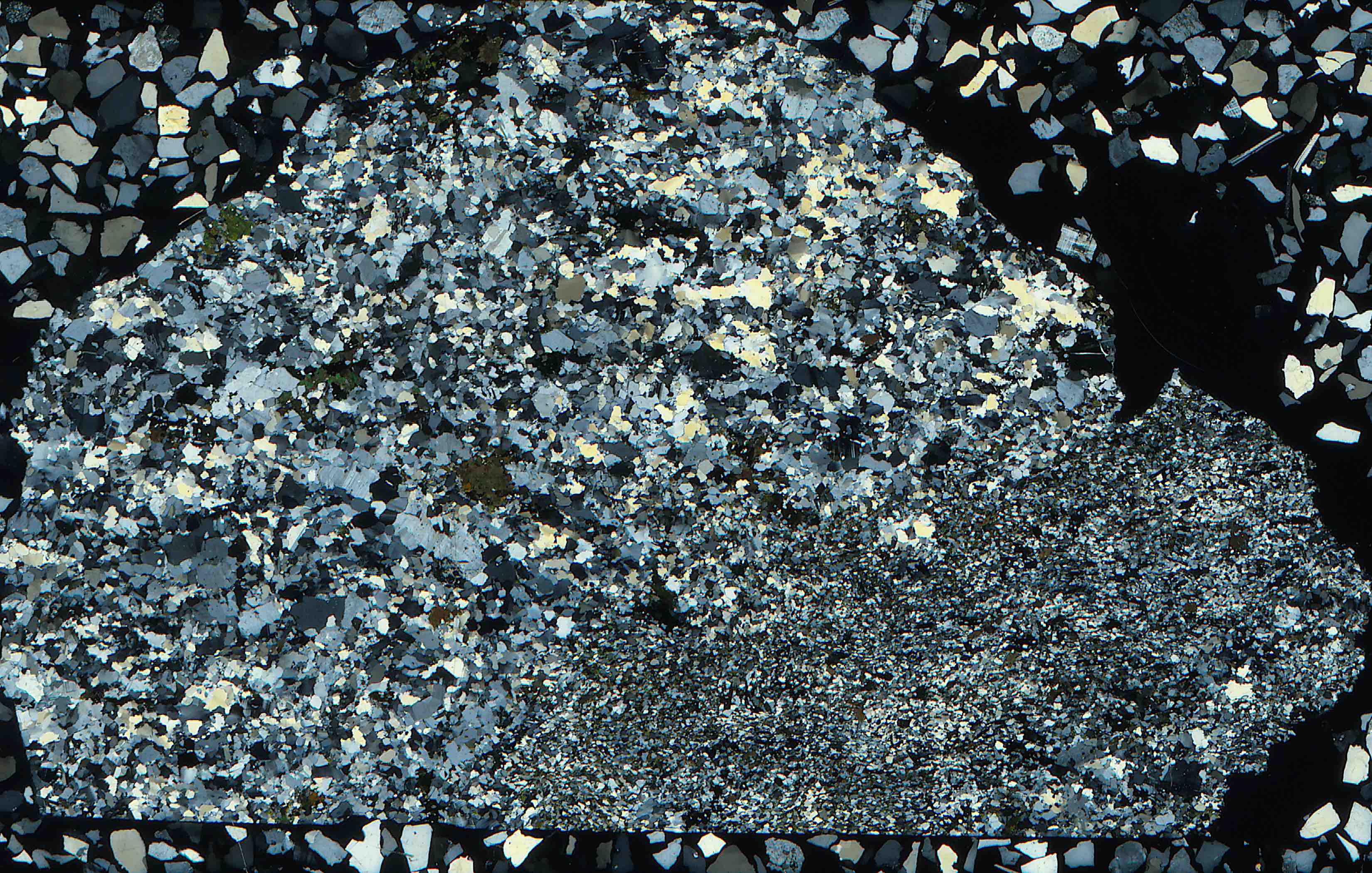
left image: unpolarized light; right image: under crossed polarizers; use slider in center to view more of either image
sample: FKM-293
locality: Fountain quarry, Fountain, Pitt Co., NC, USA.
rock type: test.
major mineralogy: specimen acquired for bafertisite.
| mineral | representative mineral compositions in FKM-293 |
|---|---|
| calcite | analysis pending |
| ilmenite | analysis pending |
| magnetite | analysis pending |
| aegirine | analysis pending |
| amphibole | analysis pending |
| microcline | analysis pending |
| “plagioclase” | analysis pending |
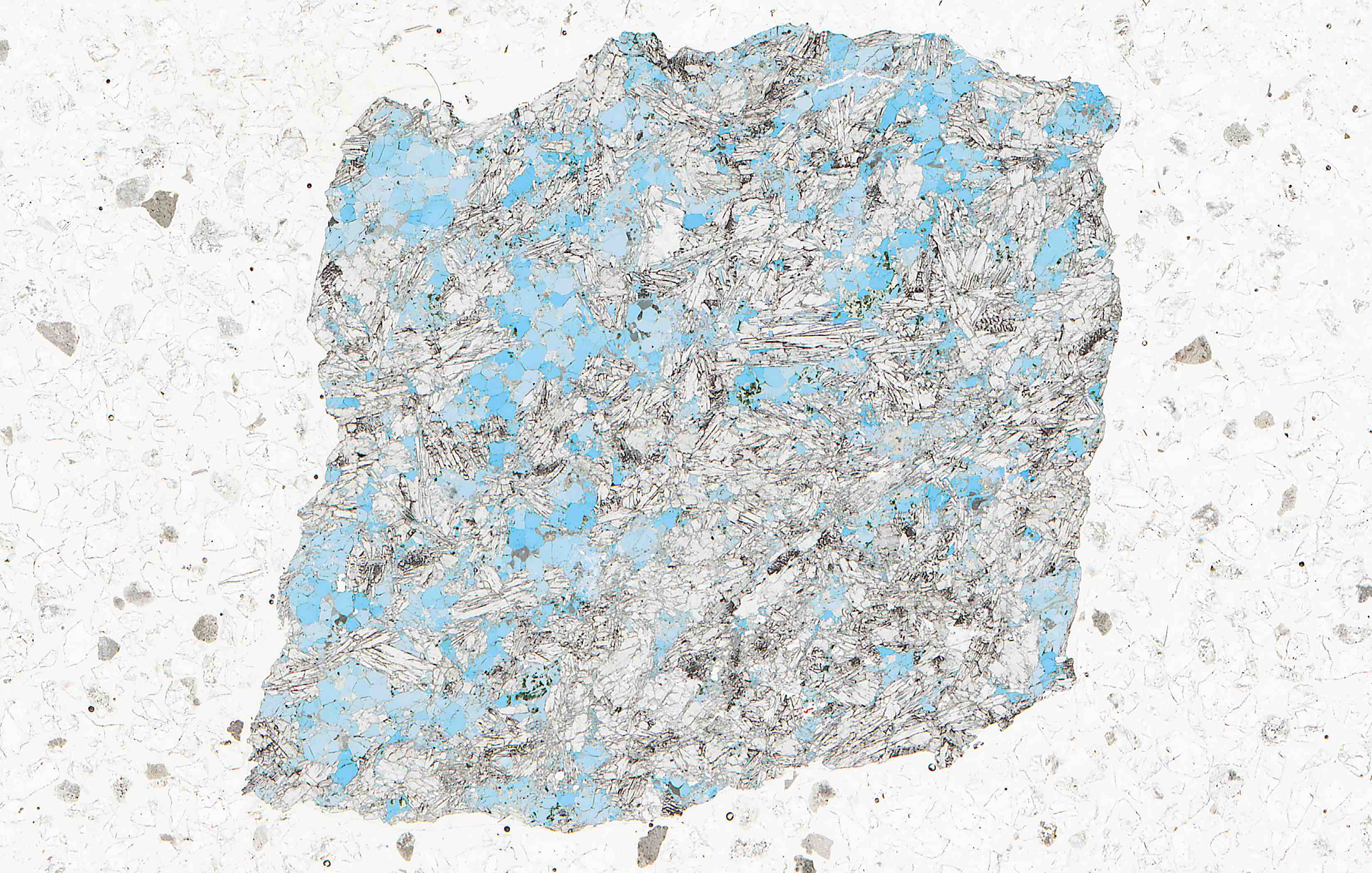

left image: unpolarized light; right image: under crossed polarizers; use slider in center to view more of either image
sample: FKM-294
locality: Hålsjöberg, Torsby, Värmland, Sweden.
rock type: test.
major mineralogy: specimen acquired for scorzalite.


left image: unpolarized light; right image: under crossed polarizers; use slider in center to view more of either image
sample: FKM-295
locality: Johnsburg township, Warren Co., NY, USA.
rock type: The sample is a high-grade B-rich magnesian calc-silicate rock.
major mineralogy: Thin rims of pargasite separate the dominant diopside from abundant Ba-enriched phlogopite and serendibite. Unlike other serendibite examples from among this thin section collection (including other material from the sample locality), this serendibite is relatively Fe-enriched and is fairly strongly-colored and pleochroic. Minor hyalophane feldspar near the ternary composition intersection of K-spar-albite-celsian is scattered within the sample. Broad zones of sub-parallel alteration veinlets and jointing, perhaps related in part to the orientation of the local stress regime, crosscut the sample (and are notable as darker bands in the PPL thin section scan); minor amounts of secondary albite is present in some of these features. Sparse to minor small barite, pyrite and very small fluorapatite are observed in the sample.
| mineral | representative mineral compositions in FKM-295 |
|---|---|
| pyrite | (Fe0.99Co0.01)S2.00 |
| barite | (Ba0.98Sr0.01Ca0.01)[S1.00O4] |
| fluorapatite (most F-rich) | (Ca5.02Na0.05)[P0.990Si0.007S0.003O4]3(F0.64[OH]0.26Cl0.10) |
| fluorapatite (most Cl-rich) | (Ca4.97Na0.05FeT0.01)[P0.993Si0.003S0.003O4]3(F0.64[OH]0.26Cl0.10) |
| diopside | (Ca0.87Na0.10Al0.16Mg0.03)(Mg0.79Al0.16Fe2+0.02Fe3+0.02Ti0.01)[Si1.90Al0.10O6] |
| serendibite (point #11) | (Ca3.35Na0.61Fe2+0.02Mn2+0.01)(Al6.38Mg5.12Fe2+0.40Fe3+0.07Ti0.02V0.01)O4[Si6.10B3.00Al2.90O36] |
| serendibite (point #13) | (Ca3.33Na0.53Fe2+0.14Mn2+0.01)(Al6.27Mg5.38Fe2+0.21Fe3+0.12Ti0.02)O4[Si6.10B2.96Al2.94O36] |
| pargasite | (Na0.76K0.19Ba0.02□0.03)(Ca1.89Na0.11)(Mg3.84Al0.80Fe3+0.14Fe2+0.11Ti0.11V0.01) [Si6.18Al1.82O22]([OH]1.41F0.36O0.22Cl0.01) |
| phlogopite | (K0.73Ba0.16Na0.09□0.02)(Mg2.53Al0.19Ti0.14FeT0.11□0.03)[Si2.70Al1.30O10]([OH]1.43O0.29F0.27Cl0.01) |
| “hyalophane” | (Ba0.38K0.33Na0.31Ca0.01)[Si2.62Al1.37O8] |
| albite | (Na0.91Ca0.07Mg0.03?)[Si2.92Al1.07Fe3+0.01O8] |
accompanying videos: Short videos featuring the mineral associations and optical properties of the serendibite and phlogopite in this thin section offer a more detailed look at this sample.
| mineral | PPL (lower polar rotation) |
PPL (stage rotation) |
XP (stage rotation) |
optic figure (stage rotation) |
|---|---|---|---|---|
| serendibite PPL: pale yellow-brown/medium blue pleochroism, high relief; XP: up to 1st order white δ, with anomalous blue overtones; with diopside |
||||
| phlogopite PPL: very pale yellow/medium orange-tan pleochroism, moderate relief; XP: up to 3rd order yellow-green δ; with diopside, serendibite and pargasite |
||||
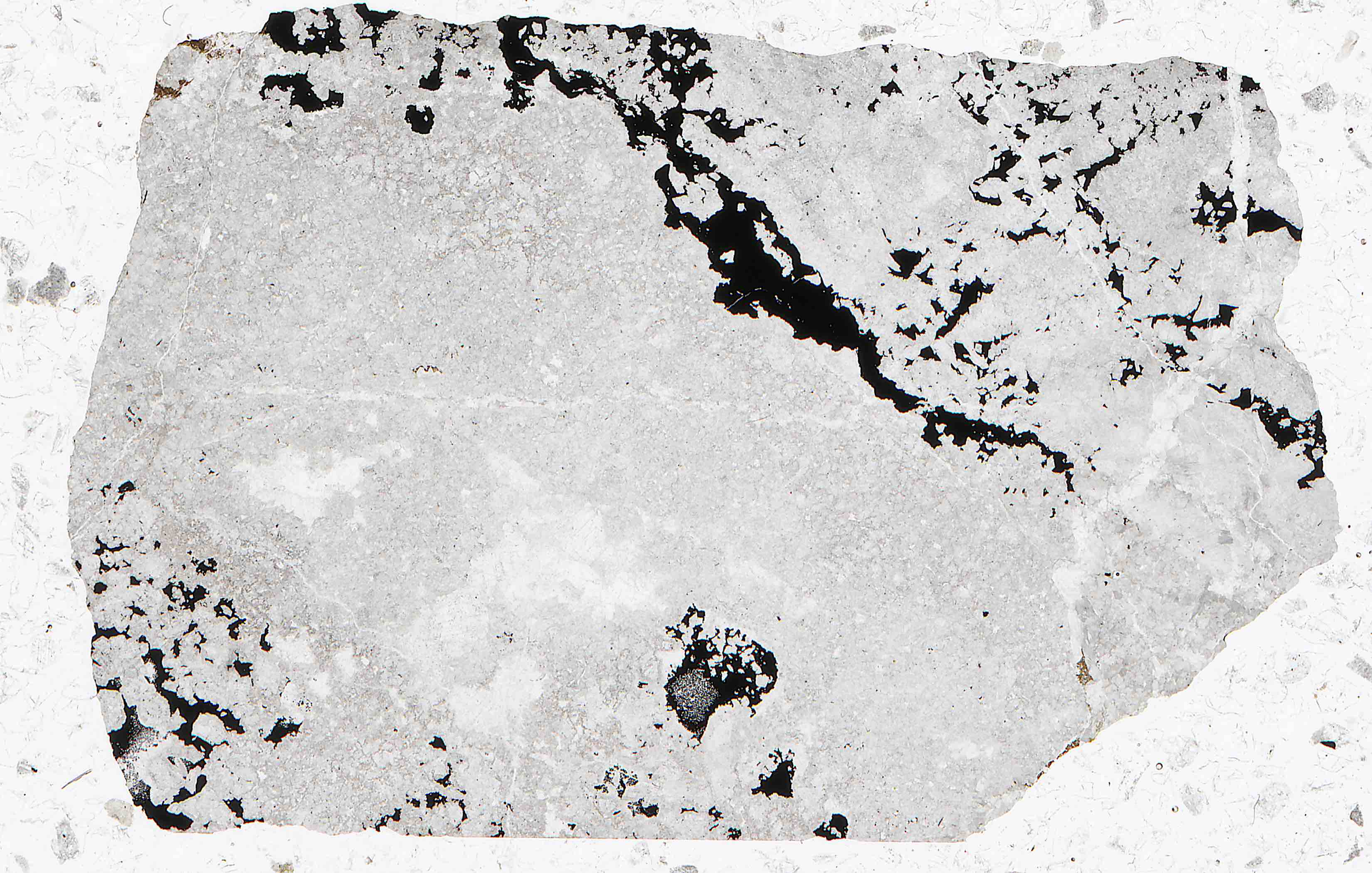
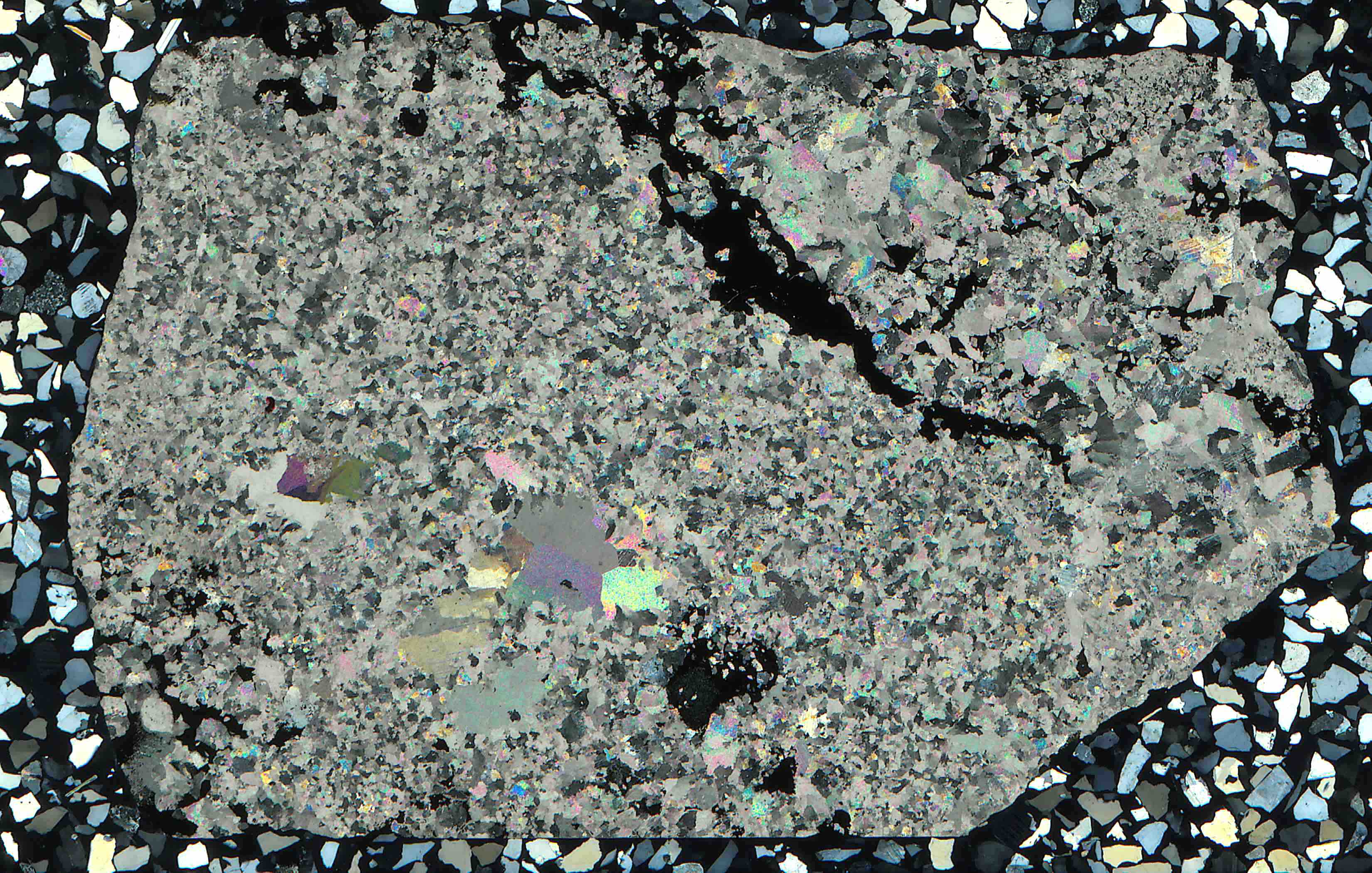
left image: unpolarized light; right image: under crossed polarizers; use slider in center to view more of either image
sample: FKM-296
locality: Bukov Mine, Rožná deposit, Rožná, Žďár nad Sázavou District, Vysočina Region, Czech Republic.
rock type: test.
major mineralogy: specimen acquired for berzelianite.


left image: unpolarized light; right image: under crossed polarizers; use slider in center to view more of either image
sample: FKM-297
locality: Gentil claim, Mendes Pimentel, Minas Gerais, Brazil.
rock type: test.
major mineralogy: specimen acquired for phosphosiderite and triphylite.

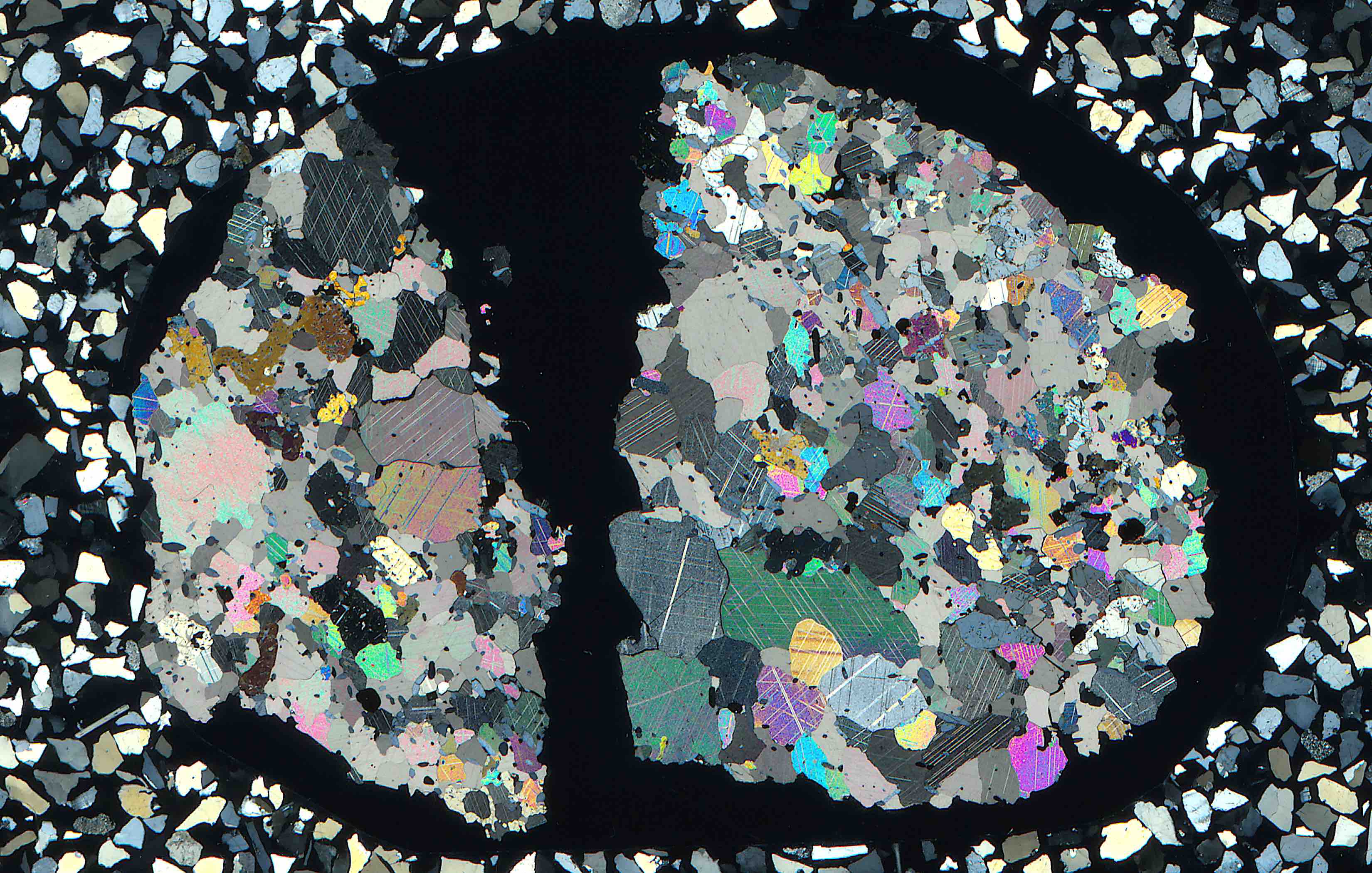
left image: unpolarized light; right image: under crossed polarizers; use slider in center to view more of either image
sample: FKM-298
locality: Oka complex, Oka, Deux-Montagnes RCM, Laurentides, Québec, Canada.
rock type: carbonatite (sövite).
major mineralogy: specimen acquired for the perovskite group mineral latrappite. However, latrappite is not present in this sample, and instead the perovskite group mineral is a patchy-zoned variably [Na+Nb]-enriched perovskite. In several places, the perovskite is associated with magnetite. Abundant in the sample are monticellite, weakly-zoned apatite, and weakly-zoned phlogopite; everything is hosted within the carbonatite’s dominant calcite. Minor accessory mineral observed include galena, pyrrhotite, “uranopyrochlore” (which normalizes to a U-rich hydroxycalciopyrochlore/fluorcalciopyrochlore boundary composition pyrochlore), britholite-(Ce) and possibly niocalite (but the one observed grain was too small to quantitatively analyze).
| mineral | representative mineral compositions in FKM-298 |
|---|---|
| galena (tiny) | Pb1.02(S0.97Se0.01) |
| pyrrhotite | Fe0.95S1.00 |
| magnetite | (Fe2+0.54Mn2+0.28Mg0.17Zn0.01)(Fe3+1.82Fe2+0.08Ti0.08Al0.01V0.01)O4 |
| perovskite (patchy higher z, mostly core) |
(Ca0.74Na0.20Ce0.02La0.01Nd0.01Sr0.01)(Ti0.50Nb0.31Fe3+0.10Fe2+0.04Ta0.03Zr0.02Al0.01)O3 |
| perovskite (patchy lower z, mostly edge) |
(Ca0.84Na0.10Ce0.02La0.01Sr0.01)(Ti0.56Nb0.25Fe3+0.13Fe2+0.03Ta0.01Zr0.01Al0.01)O3 |
| oxycalciopyrochlore?/ hydroxycalciopyrochlore? boundary pyrochlore ss (“uranopyrochlore”; small grains) |
(Ca1.14Na0.39U0.31Ce0.09La0.01Nd0.01Mn2+0.01Pb0.01Th0.01Sr0.01□0.01) (Nb1.15Ti0.52Zr0.21FeT0.07Ta0.04)O6.00(O0.46[OH]0.45F0.09) |
| calcite | Ca0.99[CO3] |
| fluorapatite/hydroxylapatite boundary apatite ss (ratty higher z core) |
(Ca4.81Ce0.10Sr0.04La0.04Nd0.02Pr0.01[M+HREE]0.01Na0.01)[P0.91Si0.087S0.003V0.003O4]3(F0.50[OH]0.50) |
| hydroxylapatite-dominant apatite ss (main z) |
(Ca4.91Ce0.08Sr0.03La0.02Nd0.02Pr0.01Y0.01Fe0.01Na0.01)[P0.913Si0.083S0.003V0.003O4]3([OH]0.53F0.47) |
| hydroxylapatite/fluorapatite near-boundary apatite ss (slightly higher z edge) |
(Ca4.71Ce0.08Sr0.03La0.03Nd0.02Pr0.01Y0.01Na0.01)[P0.937Si0.063O4]3([OH]0.51F0.48) |
| britholite-(Ce) (tiny) | (Ca2.41Ce1.33La0.81Nd0.25Pr0.11Y0.06Sr0.04Sm0.02Gd0.02[HREE]0.02Fe0.02Th0.01)[Si0.81P0.19O4]3([OH]0.85F0.15) |
| monticellite | (Ca0.97Mn2+0.03)(Mg0.69Fe2+0.21Mn2+0.10)[Si1.00O4] |
| niocalite? (tiny) | too small to analyze |
| phlogopite (patchy higher z; most [Ba+Fe+Al]-rich) |
(K0.75Ba0.12Na0.09□0.04)(Mg2.32FeT0.32Al0.24Ti0.06MnT0.05)[Si2.58Al1.42O10]([OH]1.83O0.13F0.04) |
| phlogopite (patchy main z) | (K0.81Na0.09Ba0.08□0.02)(Mg2.45FeT0.29Al0.16Ti0.05MnT0.05)[Si2.66Al1.34O10]([OH]1.87O0.09F0.04) |
| phlogopite (patchy lower z; most [K+Mg+Si]-rich) |
(K0.87Na0.08Ba0.04□0.01)(Mg2.72FeT0.22MnT0.04Ti0.01)[Si2.93Al1.07O10]([OH]1.92F0.05O0.02) |
accompanying videos: Short videos featuring the mineral associations and optical properties of the calcite, monticellite and phlogopite in this thin section offer a more detailed look at this sample.
| mineral | PPL (lower polar rotation) |
PPL (stage rotation) |
XP (stage rotation) |
optic figure (stage rotation) |
|---|---|---|---|---|
| calcite PPL: colorless, variable relief upon stage rotation; XP: high order pastel-creamy δ; with apatite |
||||
| monticellite PPL: colorless, moderate-high relief; XP: up to 1st order straw yellow δ; with calcite, diopside and apatite |
||||
| phlogopite PPL: very pale tan/medium-light brown pleochroism, moderate relief; XP: up to 3rd order blue δ; with calcite, magnetite (opaque) and apatite |
||||
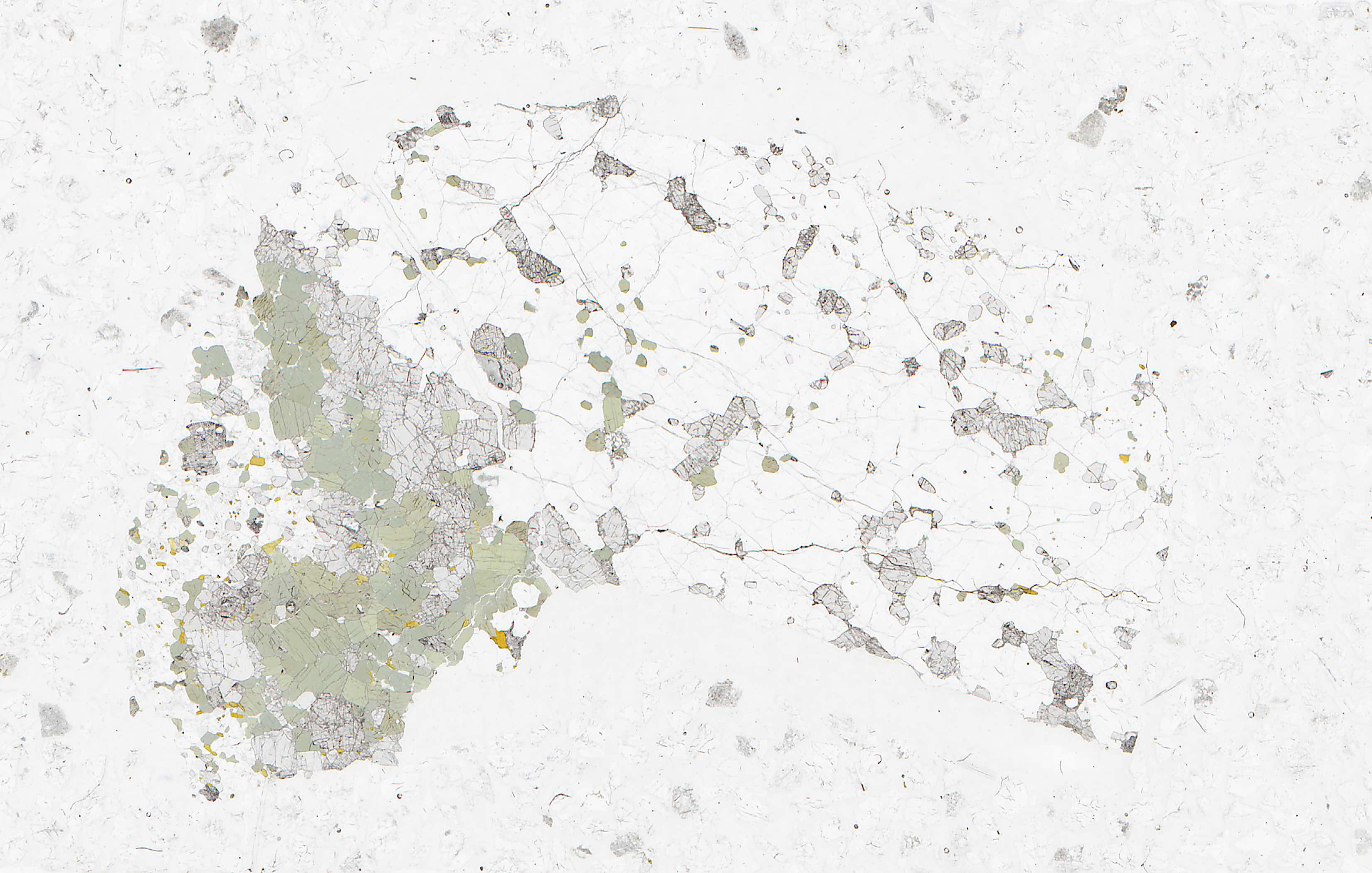
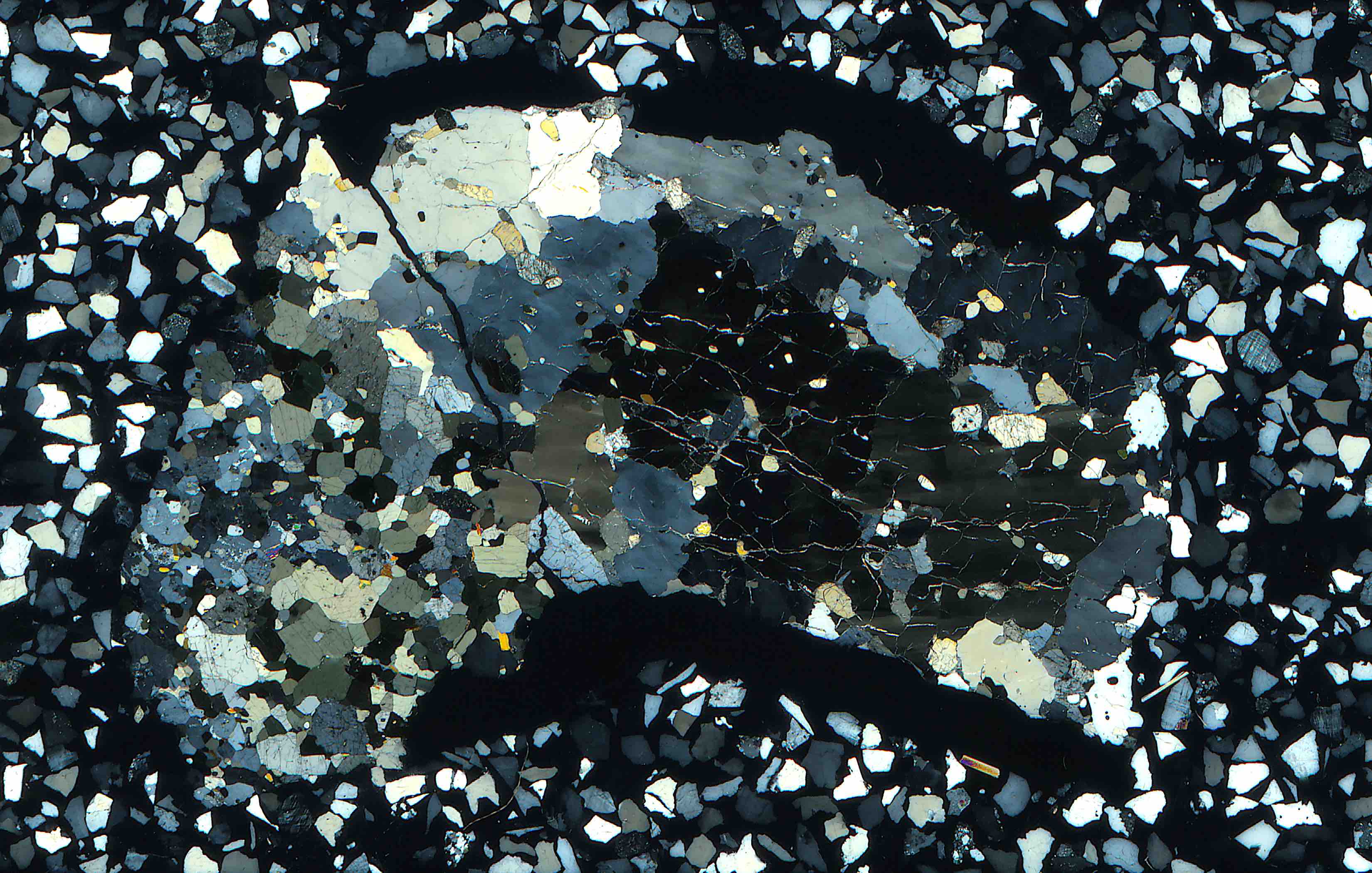
left image: unpolarized light; right image: under crossed polarizers; use slider in center to view more of either image
sample: FKM-299
locality: Taguchi mine, Shidara-cho, Kita-Shidara-gun, Aichi, Japan.
rock type: essentially a yoshimuraite-vittinkiite-hjalmarite-quartz “amphibolite”, presumably the result of high grade metamorphism (± metasomatism?) of a Mn-rich siliceous exhalite.
major mineralogy: The specimen was acquired for yoshimuraite, and additionally rhodonite and richterite were presumed to be present based on the locality description and subsequent optical examination of the thin section (note: low-Ca rhodonite and pyroxmangite can be difficult to differentiate from chemistry alone without accompanying structural analysis, but the material in this sample has a maximum δ of 1st order gray-yellow, a 2V° of ~60°±10°, and moderate r < v dispersion; although pyroxmangite isn't unequivocally precluded by these optical data, the combination of these properties appear to make a rhodonite-group mineral a more probable identification). The yoshimuraite shows [P]≈[S]. Two distinct pyroxenoids were identified. The most abundant one appears to be "rhodonite" (sensu lato), but upon analysis, assuming the M4 site contains all of the smaller Fe2+ and Mg in addition to whatever balance of Mn2+ is necessary to fill the site, then the species appears to fall essentially more precisely at the M4(Mn2+0.33Fe2+0.33Mg0.33) ternary boundary. With the recognition of the new M4Fe2+-dominant species ferrorhodonite in 2016 and the new M5Mn2+-dominant species vittinkiite in 2019, this material from the Taguchi mine may actually represent an intriguing ternary solid solution roughly approximating vittinkiite0.33-“ferrovittinkiite”0.33-“magnesio-vittinkiite”0.33 (the latter two unrecognized but presumably hypothetical end-members). Within the rhodonite (sensu lato), scattered lower “z” patches and zones (representing later metasomatism?) appear to correspond to a second pyroxenoid, nambulite. Although Li can not be measured by EPMA, including an appropriate amount of calculated Li in the normalization simultaneously satisfies the (Li+Na) site filling, the overall charge balance, the requirement that Si=~5.00 apfu, and the overall analytical total. The most abundant Mn-bearing silicate in the sample is actually an amphibole. Although purported to be richterite, the amphibole would not normalize to a conventional richterite composition. Normalized to ∑Si=8 (see table below), 0.47 apfu BMn2+ is present, and this coupled with an additional 0.20 apfu BCa yields a total ∑BM2+ occupancy of 0.67 apfu; hence the nominal idealized end-member composition corresponds to a B(NaMn2+)-group amphibole. Note that this composition differs from richterite by the exchange vector [BMn2+]1[BCa2+]-1. According to table 7 in Hawthorne et al., 2012, this amphibole composition is referred to by the placeholder “rootname 13”, although due to potentially significant measured CM3+ (primarily Fe3+), this Taguchi mine amphibole composition actually more closely falls along the join between “rootname 13” and ferri-“rootname 11” (this latter species now named ferri-ghoseite). Note also that the Fe3+ content is calculated from total Fe based on a 8Si (∑Si=8) normalization; the only other cation-based normalization that results in a high-quality normalization is 8SiAl (∑[Si+Al]=8), and this alternative normalization yields an essentially equivalent value for Fe3+, owing to the low abundance of Al in the sample. Hence, the assessment that the analyzed Taguchi mine amphibole falls along the “rootname 13” and ferri-ghoseite join is very compelling. In late 2018, an amphibole corresponding to “rootname 13”, from Långban, Sweden, was subsequently characterized by Holtstam et al., 2019 [← subscription required] and named hjalmarite. The low-Fe hjalmarite from Långban is colorless and non-pleochroic, whereas in contrast, the Fe-bearing Taguchi mine material is strongly pleochroic in shades of tan, buff and green. With the presumed occurrence of nambulite in the sample, the possibility of minor Li in the amphibole can not be discounted. However, the maximum amount of Li would need to be limited by the otherwise good analytical total, so it is unlikely sufficient Li could be present to significantly alter the normalization and species assignment; nonetheless, this will be evaluated by ICP-MS or SIMS in the future. Finally, quartz and a lesser amount of barian orthoclase (with orange-red cathodoluminescence) round out the dominant minerals in the sample. Minor barite and rhodochrosite are also present, and extremely rare tiny pyrite crystals (so small that their measured elevated Mn contents may in part be due to overlap by adjacent Mn silicates) was observed. One thin veinlet cross-cutting the sample appears to be filled with minor additional barite and possibly a low-total poorly-characterized Ba-bearing clay or zeolite.
| mineral | representative mineral compositions in FKM-299 |
|---|---|
| pyrite | (Fe0.97Mn0.03)S2.00 |
| rhodochrosite (most Ca+Mg-rich) |
(Mn2+0.86Ca0.11Mg0.03)[CO3] |
| rhodochrosite (most Mn-rich) |
(Mn2+0.91Ca0.08Mg0.02)[CO3] |
| barite | Ba1.00[S1.00O4] |
| yoshimuraite | (Ba1.80Sr0.21)(Mn2+1.50Fe2+0.50)(Ti0.88Mg0.10Al0.01V0.01)O1.00[Si2.00O7][P0.48S0.47Si0.05O4](OH) |
| nambulite | (Li~0.72Na0.25Ca0.03)(Mn2+0.93Ca0.06)Mn2+1.00Mn2+1.00(Mn2+0.37Mg0.36Fe2+0.27)[Si5.00O14](OH) |
| “magnesiovittinkiite”/vittinkiite/ “ferrovittinkiite” boundary rhodonite group ss |
(Mn2+0.73Ca0.26Sr0.01)Mn2+1.00Mn2+1.00Mn2+1.00(Fe2+0.33Mg0.33Mn2+0.32Fe3+0.01)[Si4.99Fe3+0.01O15] |
| hjalmarite-[ferri-ghoseite] join B(NaMn2+)-amph ss (Hawthorne et al., 2012) |
(Na0.56K0.19Sr0.02□0.23)(Na1.33Mn2+0.47Ca0.20)(Mg2.96Mn2+0.78Fe2+0.65Fe3+0.49Ti0.06Al0.04Ni0.02) [Si8.00O22]([OH]1.74F0.15O0.11) |
| orthoclase (most K-rich) |
(K0.90Na0.06Ba0.03)[Si2.98Al1.02O8] |
| orthoclase (most Na+Ba-rich) |
(K0.75Na0.17Ba0.06)[Si2.93Al1.04Fe3+0.03O8] |
| quartz | not analyzed |
accompanying videos: Short videos featuring the mineral associations and optical properties of the yoshimuraite and hjalmarite-[ferri-ghoseite]-join amphibole in this thin section offer a more detailed look at this sample.
| mineral | PPL (lower polar rotation) |
PPL (stage rotation) |
XP (stage rotation) |
optic figure (stage rotation) |
|---|---|---|---|---|
| yoshimuraite PPL: weak brownish-orange pleochroism, high relief; XP: up to 2nd order blue δ, although body color of mineral partially masks birefringence; with “rhodonite”, amphibole and quartz |
||||
| hjalmarite-[ferri-ghoseite] PPL: brown/green/pale buff pleochroism, moderate-high relief; XP: up to 1st order yellow δ; with quartz, “rhodonite” and yoshimuraite |
||||
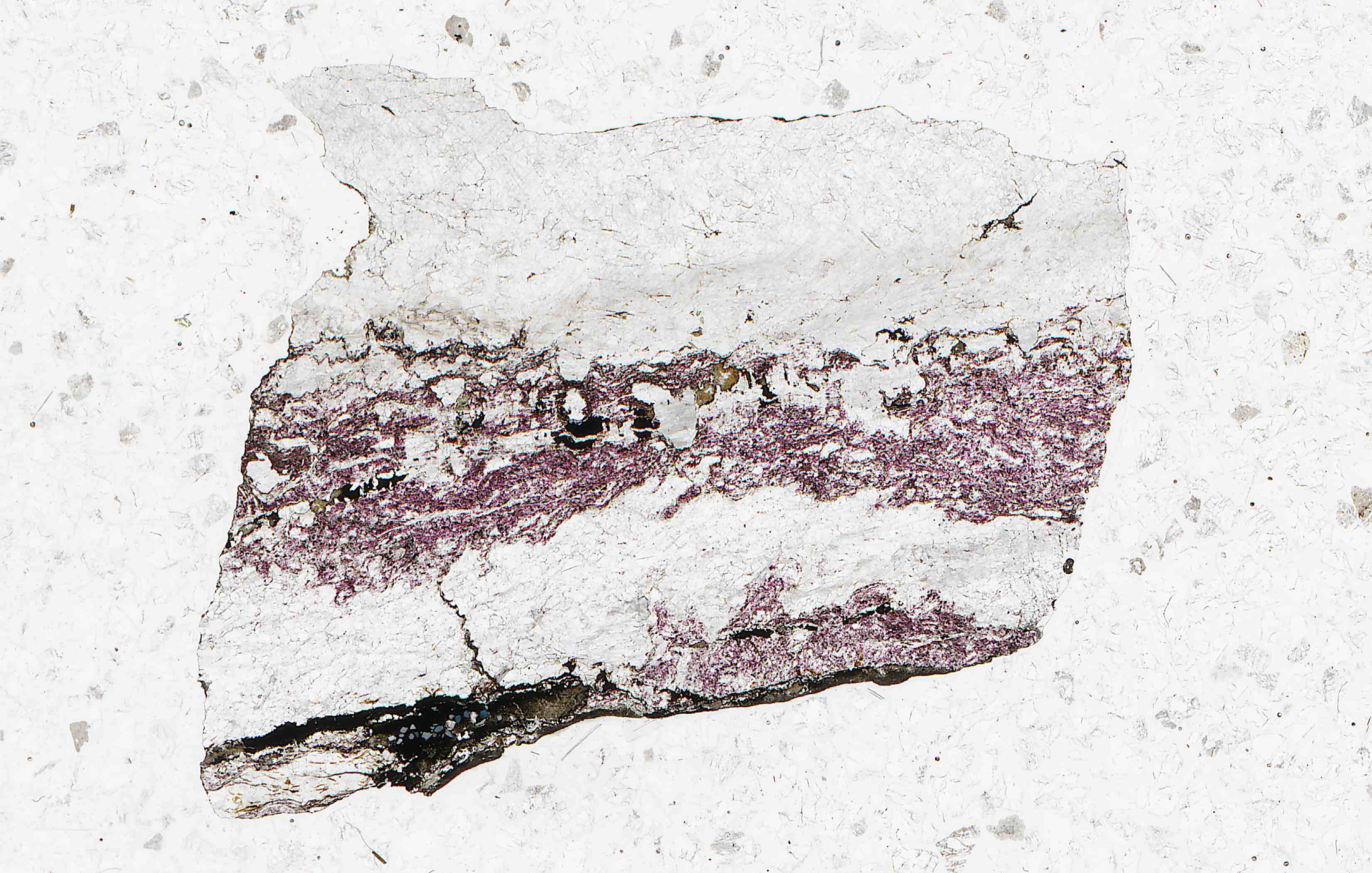
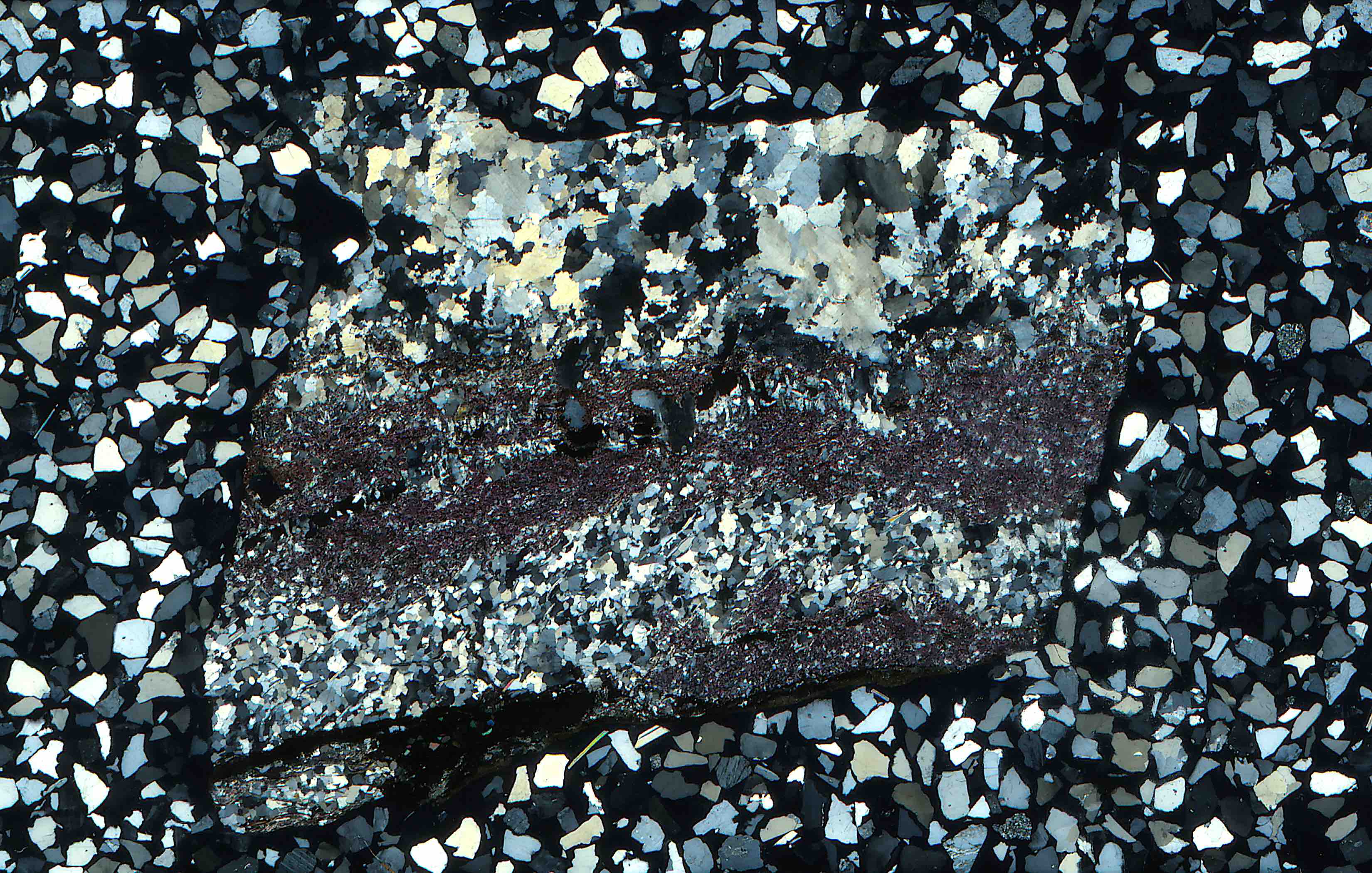
left image: unpolarized light; right image: under crossed polarizers; use slider in center to view more of either image
sample: FKM-300
locality: Arrow Junction Quarry, Arrow Junction, Queenstown-Lakes District, Otago Region, South Island, New Zealand.
rock type: test.
major mineralogy: specimen acquired for ardennite-(As) and piemontite.